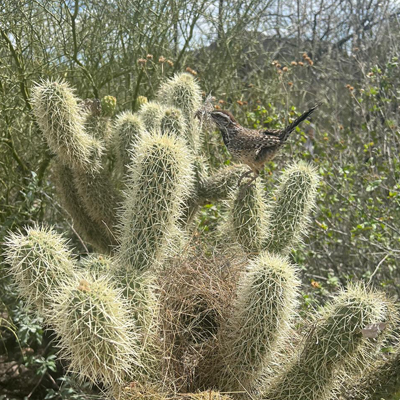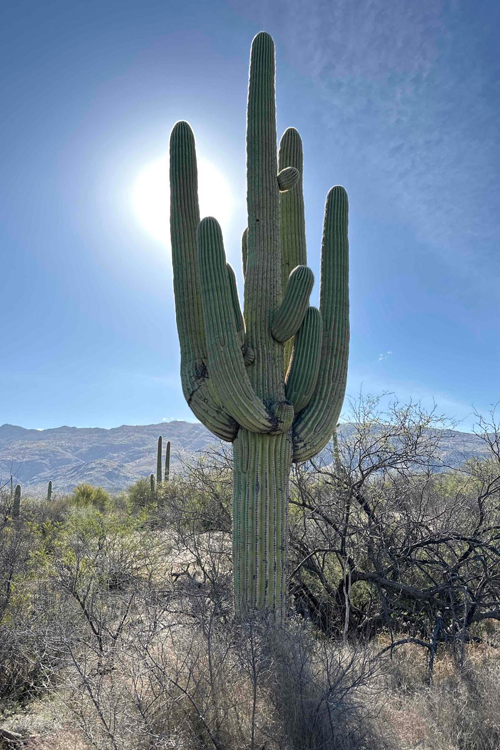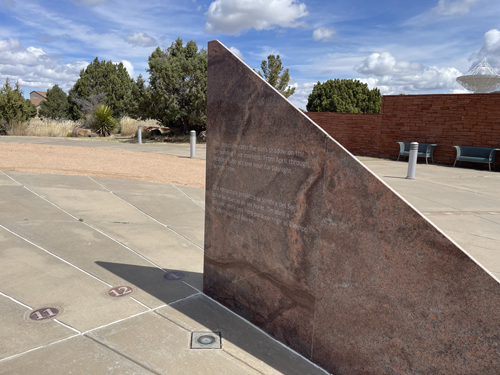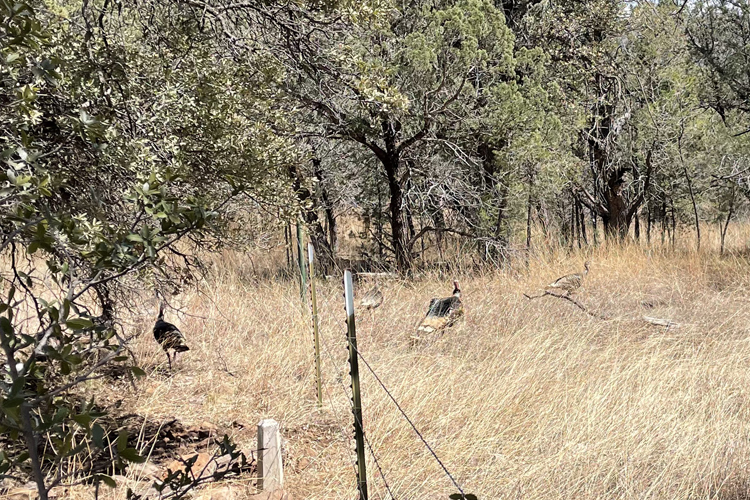
| Prologue | Wk 1: CA Hills to AZ Desert | Wk 2: High Desert to TX | Wk 3: TX Hill Country | Wk 4: Flowers and trees to LA | Wk 5: Mississippi to the Gulf | Wk 6: Florida Panhandle to the Ocean | Epilogue |
P.J.O'Rourke in 2011 Wall Street Journal op-ed: "It's impossible to feel like a grown-up when you are on a bicycle." He meant it as an insult. I treat it as a compliment.
Week 2: Tucson AZ to Fort Davis TX. 603 Miles. 18,000ft elevation 1072 Total Miles
Well, this was quite a week. Eight days of riding (all the other weeks are six) and a very mixed bag of weather.
Sunday March 12 Tucson AZ to Benson AZ Elevation: 3586ft
Temp: 53f - 68f Ascent: 3848ft Distance 65 Miles
|
Our usual 8:00a start, and we'd only been on the road about 10 miles when we got to the Saguaro National Park, where we did the 8 mile road loop through the park. Despite leaving my National Park membership card at home—an unforgivable sin since I knew we were coming here—I was able to sweet-talk the Ranger into letting me in, based on the photo's CMT had sent, which means I and four others were in too. I think there were enough cards to do the whole crew, which was a great win for Dennis. Looks like a cactus. Looks like a wren. No surprise then that this is an excellent pic someone grabbed of a Cactus Wren. My guess is Billy-Bob.
The road was absolutely spectacular. One way, up and down, threading its way around one fabulous vista after another. A bicycle is the perfect tool for this job. All around visibility, the scents of the desert in your nostrils, stopping wherever you want, and 10 - 15 miles per hour is an ideal speed. It is hard to believe it was only 68F. It felt way warmer than that. |
Another award-winning shot I stole shamelessly from an anonymous teammate.
|
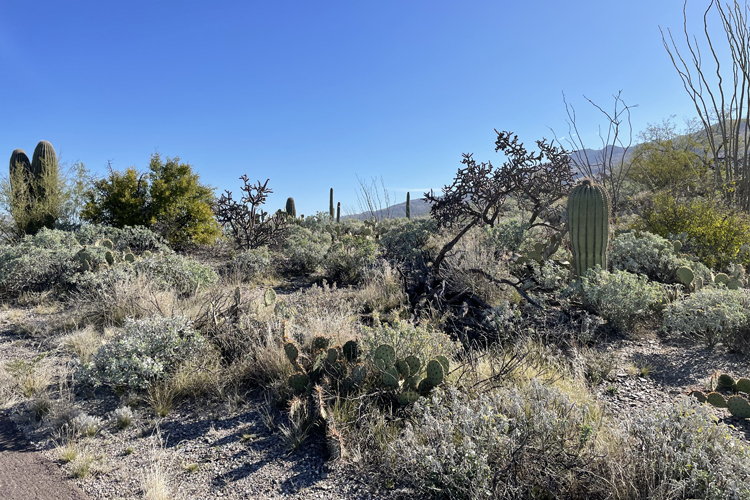
|
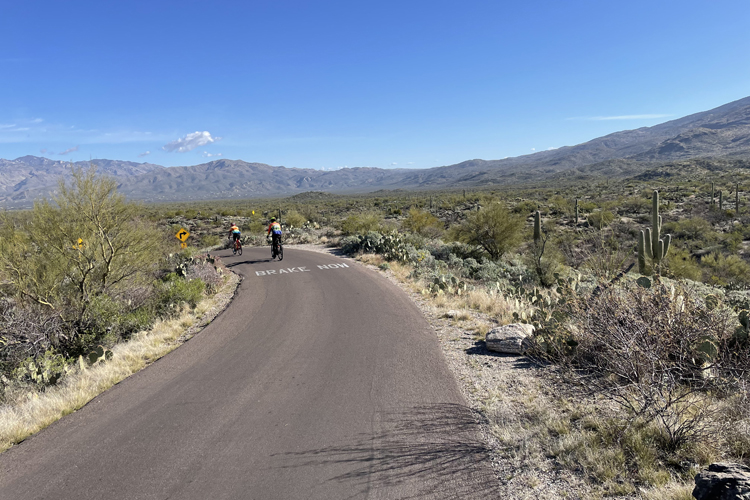
|
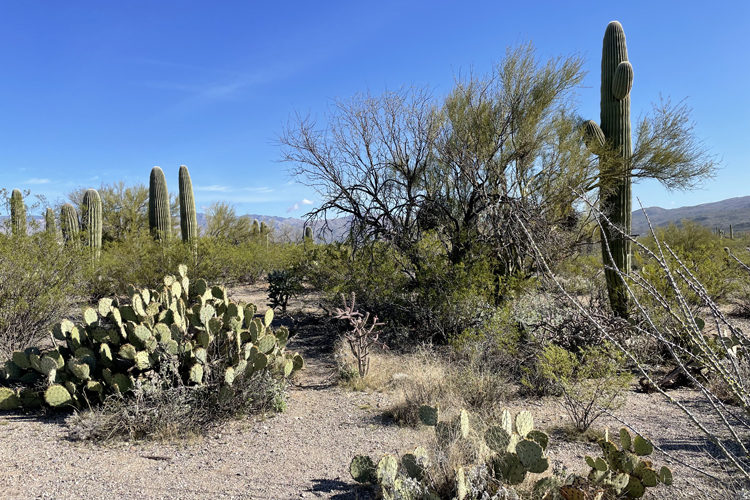
|
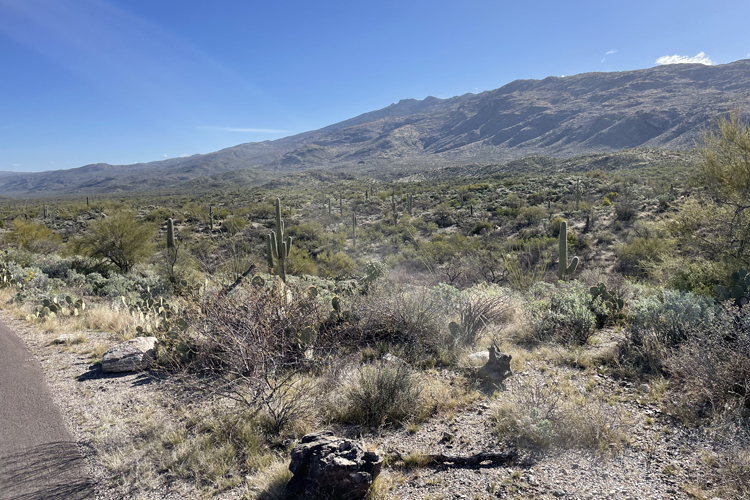
|

|
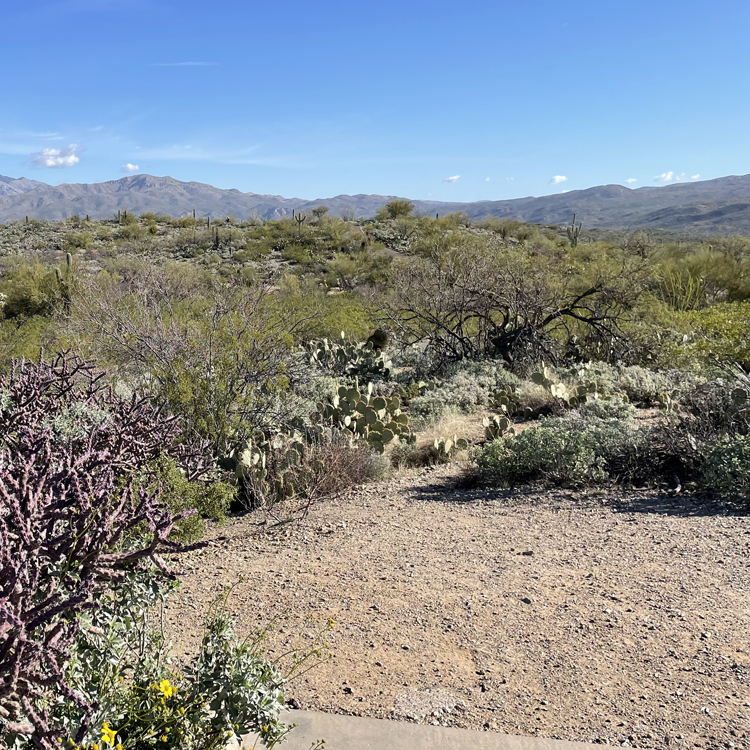
|
The rest of the day must have been humdrum because I have absolutely no notes. It was only 65 miles, but it was also nearly 4000ft of climbing, and even ended 1000ft higher than we started. So something must have been going seriously right for it to warrant no comment.
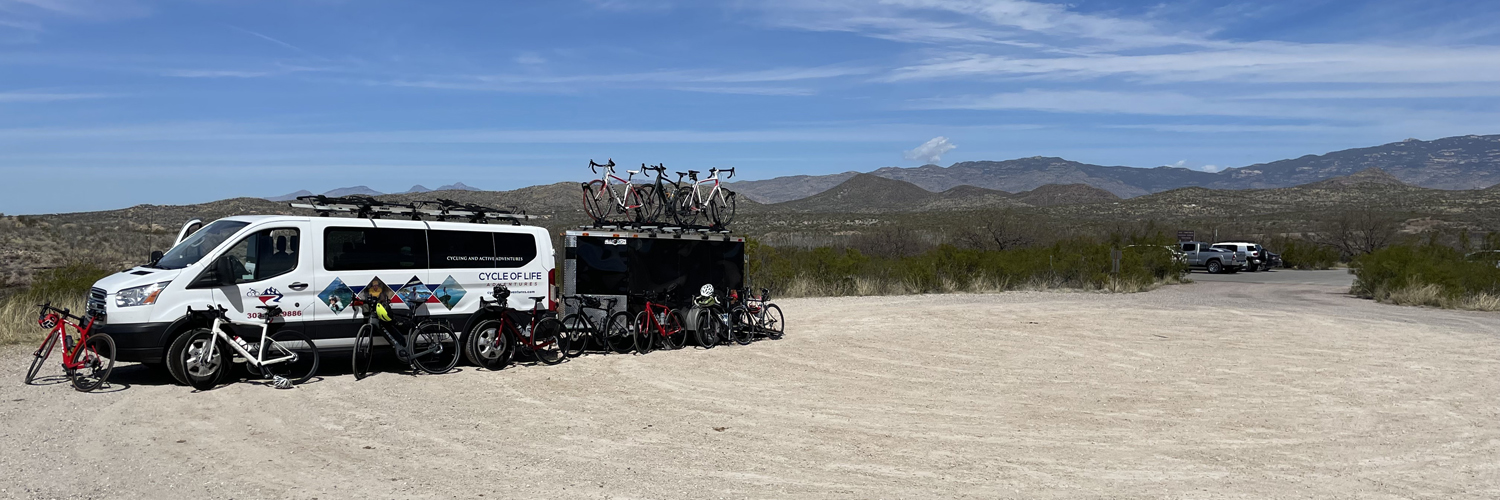
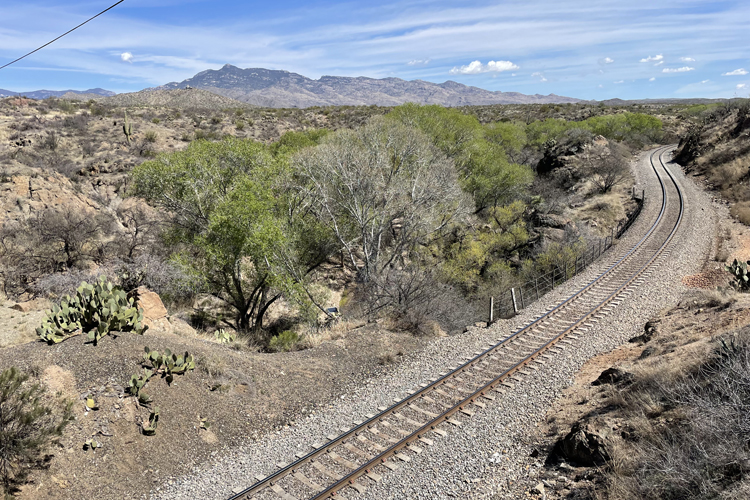
|
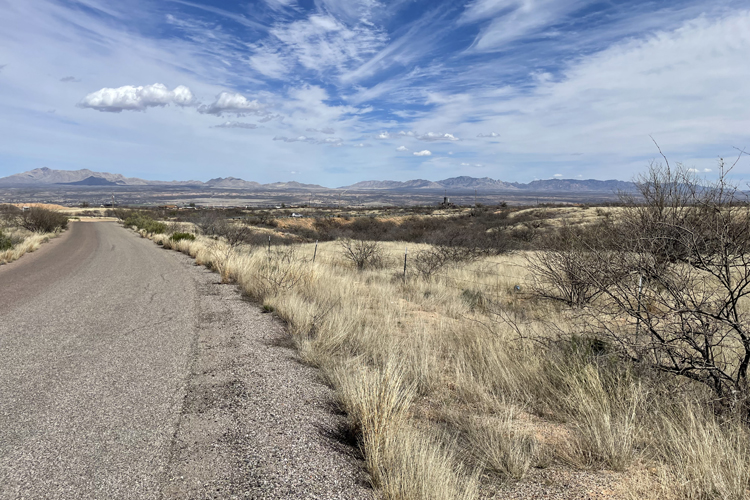
|
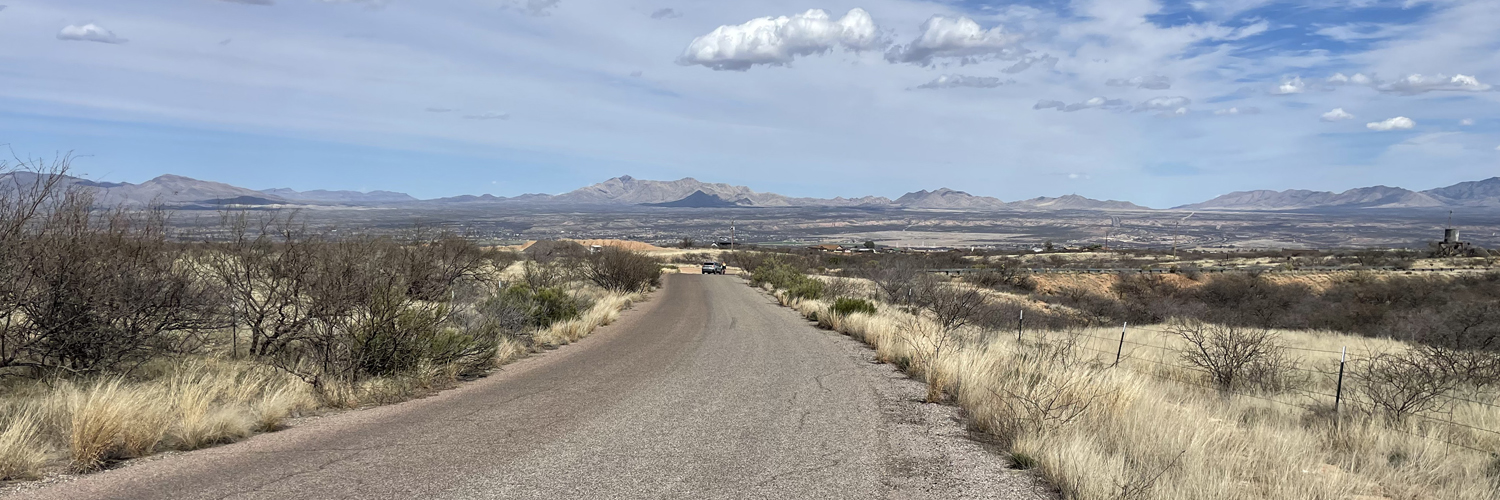
The nightstop was a Quality Inn, a typically funky motel with a nice little pool and a hot tub between the buildings that we soaked in for a while. Some teens idled at the other end of the pool and I noticed that they took over the hot tub as soon as we vacated it, and were still in it when we got back from dinner.
Speaking of dinner, we walked under the highway to Dickey's Barbecue Pit. I was imagining a much closer relationship with the actual pit than the McDonald's like modern square box in the middle of a parking lot we actually found, but it didn't stop the food being good. Randomly I was first at the counter, and without prompting the server recommended the special: burnt pork ends. That would be a Yes! The next two people up ordered it too, but when candidate number four again asked, they had already run out. A pretty special special. Most people after that went with brisket, pulled pork, or both. The usual choice of sides, and I made my usual choices of savory baked beans, dill pickles and somebody else shared their fried okra which were way better than I was expecting.
What they didn't have was beer, and though no one else seemed to like to mention it, when I suggested a beer run when Bobby went to get supplies, I was delighted that several others expressed interest. So after Bobby and I managed to sort out why 6 bottles of beer cost me $80 (they'd charged me the 4-pack price for each of the bottles in the pack) we returned with the loot and Doug and Kevin invited the beer and any takers over to their room "to watch the baseball". Even Dennis showed up.
Trains again at night. This time with multiple series of long whistles. We hadn't seen the trains all day, and didn't see where they came from or went to during the night either.
Monday March 13 Benson AZ to Bisbee AZ Elevation: 5538ft
Temp: 49f - 68f Ascent: 3258ft Distance 50 Miles
The sixth straight day of sleeping higher than waking up. It is hard to believe that Saguaro was only yesterday, and this may partially explain why last week feels like a completely different adventure: it is such a distant memory it is hard to believe we are on the same trip. Benson to Bisbee makes almost no progress eastwards instead heading towards the border, hence another Border Patrol check point for northbound traffic. It is the second day of hockey stick elevation: long long gentle incline and at the end a short sharp climb followed by a descent into town. But the climb was a doozy: 6 miles and 1400 ft up to 6045ft, (depending on who's counting) the highest elevation on the whole trip. The day was deliberately short to allow as much time as we wanted in Tombstone, and because there was a big climb after that.
Tombstone

The huge bonus of this southerly route does is that it took us right through Tombstone. I happened to be on my own as I entered town, and I noticed a sign for Boothill. It turns out that this was a fairly popular name for a cemetery, but the most notable one is surely the Boothill Graveyard in Tombstone. The plot features the graves of Billy Clanton, Frank McLaury and Tom McLaury; the three men who were killed during the famed Gunfight at the O.K. Corral.
Boothill cemetery was closed in late 1886, as the new "City Cemetery" opened. It was across the busy road, but it was not off the route, so I was able to peek through the fence with one eye while keeping the other on the road watching for Dennis, who rightly is not impressed if he accidently passes you. I felt guilty about poking my phone through the fence and grabbing a shot instead of paying the entrance fee so I could take the snap legally, but like I said, I couldn't lose sight of the road.
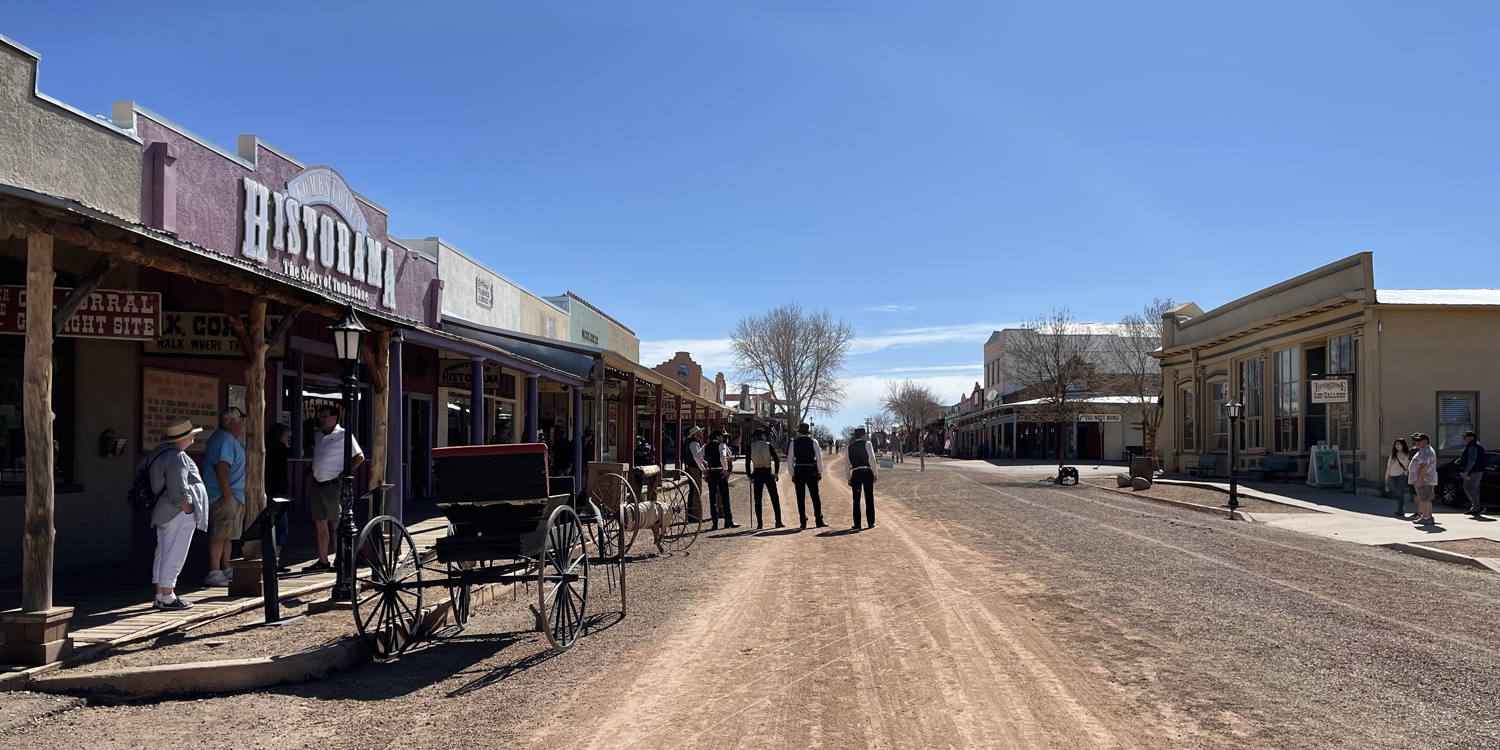
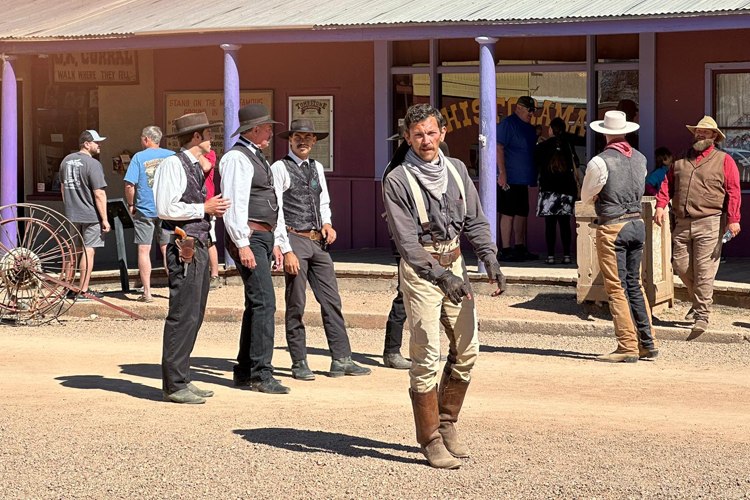
I was surprised by how nicely done Tombstone's main street was. Dirt road, every store "authentic" and with suitably costumed staff. The gun fighters milling about in the street turned out to be "the good guys" in the OK Corral reenactment show we were waiting to see. But between shows they just hang out in the street waiting for tourists like me to pose with them. I preferred the hanging out in the street to the actual show, but that's just me.
A shot of whiskey in a "western" saloon was on my fantasy wish list, and if it was possible anywhere, surely this was it. We found just the place. Doc Holliday's Saloon. I walked in with the two Daves. One had a beer, the other non-drinker hung back and took photographs. "I'd like a shot of your cheapest crappiest whiskey please." The barman had no problem with that. It was cheap. It was crappy. I loved it. Old Crow. Dave encouraged me to turn the bottom third of the shot into a Boilermaker to help him finish the beer. Perfect.
| The saloon ... 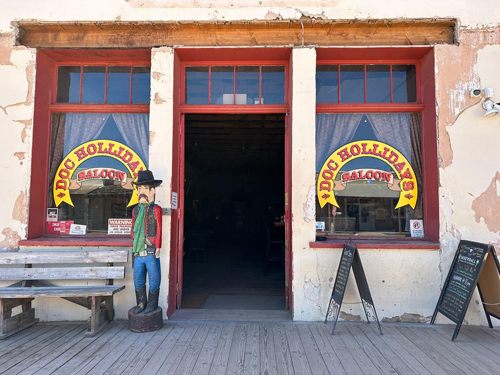
|
... the shot ... 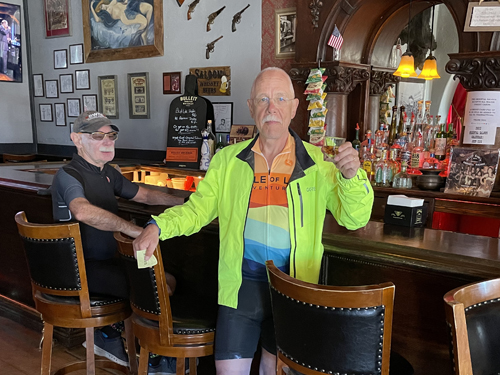
|
... the whiskey ... 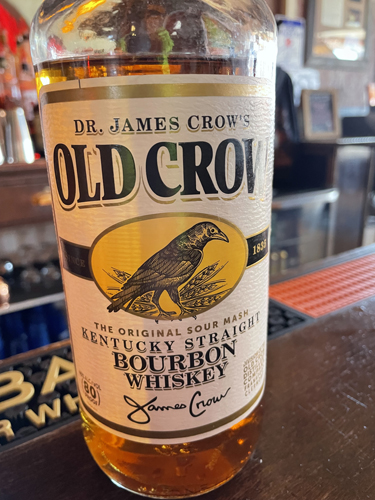
|
... the Boilermaker. 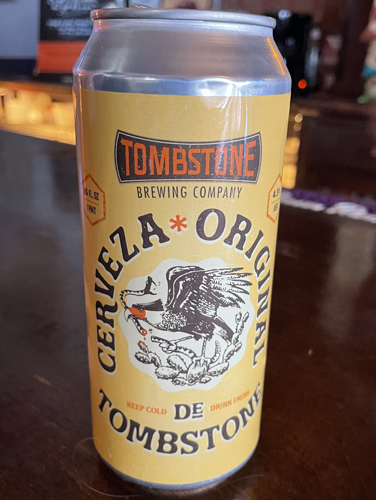
|
Then on to the Shoot Out Show. Totally kitsch. I'm glad the Daves and I went because I would forever have wondered what I missed, but I would not have missed much. The show was housed in a little theatre created specifically for the purpose: and open air street scene with bleachers for the audience under a canopy on "the other side of the street". The three-year old sitting in front of us freaked out when the bad guys were gunned down, reminding me of my own experience being removed from the movie theatre at a similar age because if I saw 101 Dalmatians Cruella DeVille one more time I would have needed therapy.
Gunfight at the O.K. CorralWhen the Earp brothers arrived in Tombstone, Arizona Territory in 1880, they were almost immediately at odds with the Clanton family and their ranch hands who had been “lording” it over Tombstone and the surrounding area without interference before the Earps arrived in town. They were members of a loosely organized group of outlaws called the Cowboys. Wyatt is often erroneously regarded as the central figure in the shoot out, but his brother Virgil was Tombstone's Town Marshal and Deputy U.S. Marshal that day, and had far more experience as a sheriff, constable, marshal, and soldier in combat. Wyatt was only a temporary assistant marshal to his brother. Virgil Earp immediately suspected the “Cowboys” of rustling cattle on a large scale and set out to stop their criminal endeavors. The gunfight then was the result of this long-simmering feud. Virgil made the decision to enforce a city ordinance prohibiting carrying weapons in town and to disarm the Cowboys. After a number of run-ins between the two factions, it came to a head on Wednesday October 26, 1881, when Virgil arrested Ike Clanton and Tom McLaury for carrying firearms in the city limits. After the pair were released, they joined up with Billy Clanton and Frank McLaury, who had just arrived in town. Marshal Earp decided to disarm Billy Clanton and Frank McLaury, as well. Virgil recruited his brothers Wyatt and Morgan to help him in this dangerous task. Doc Holliday also insisted on joining them. At about 3pm, when the four men approached the “Cowboys,” demanding their guns, all hell broke loose. Despite its name, the gunfight did not take place at the O.K. Corral, rather it played out in a narrow lot on the side of C. S. Fly's photography studio on Fremont Street, six doors west of the O.K. Corral's rear entrance. Cowboys Billy Claiborne, brothers Ike and Billy Clanton, and brothers Tom and Frank McLaury were on one side and on the other side were Marshal Virgil Earp, his two brothers (and Special Policemen) Morgan and Wyatt Earp, and temporary policeman Doc Holliday. Ike Clanton, Billy Claiborne, and Wes Fuller ran from the fight. It is not really known who fired the first shot, but Doc Holliday’s bullet was the first to hit home, tearing through Frank McLaury’s belly and sending McLaury’s own shot wild through Wyatt’s coat-tail. Virgil took a shot through the calf, most likely from Frank McLaury’s six-shooter. Billy Clanton took a bullet in the chest, probably from Morgan, then a shot in the right wrist. He switched gun hands, leaned back against a building and slowly crumpled to the ground as he continued firing. Morgan stumbled and fell, yelling, ‘I am hit,’ as a bullet entered one shoulder blade and passed out through the other. With Morgan and Virgil Earp both wounded and Holliday grazed across the side, Wyatt Earp remained the only participant standing, untouched by lead. The 30-second shootout left Billy Clanton, Frank McLaury, and Tom McLaury dead. Sheriff Behan strode over to Wyatt and said, ‘I will have to arrest you.’ A witness recalled Earp’s reply: ‘I wont be arrested. You deceived me, Johnny, you told me they were not armed. I won't be arrested, but I am here to answer what I have done. I am not going to leave town.’ And Earp was not arrested — not then, at least. Almost immediately, journalist Richard Rule from The Nugget and his rivals at the Epitaph began collecting the news. By the Epitaph report, the battle began when two Cowboys pulled their guns and fired the first two shots. The Nugget had a different take, saying Frank McLaury made a motion for his gun, which prompted Wyatt Earp to quickly draw and shoot McLaury, but both stories led to a belief that the law officers had been in the right. Within 48 hours, the situation changed dramatically. Sheriff John Behan arrested Virgil, Wyatt, and Morgan Earp, as well as Doc Holliday for the murder of Billy Clanton and Tom and Frank McLaury. However, Judge Wells Spicer, who was related to the Earps, decided that the defendants had been justified in their actions. There isn’t much room for moral ambiguity in standard depictions of the Old West but here there seems to have been plenty. Alliances were strong in the small town. Newspapers were not above taking sides, and witnesses of the scuffle gave conflicting testimony. To further complicate matters, the transcript of the ensuing murder trial was destroyed in a fire. All in all, we may never know for sure who provoked the shoot out. As the coroner’s inquest began, Sheriff Behan, along with Ike Clanton, Claiborne and several Cowboy friends, testified to a much different beginning to the gunfight. They claimed that the Earp party fired the first several shots of the conflict. Clanton filed murder charges against the Earps, and a month-long preliminary hearing began. They laid out a dramatic story of how at Virgil’s command the two Clantons and Frank McLaury thrust their arms in the air to comply, while Tom McLaury threw open his vest to show he was unarmed. Two shots were fired, the first from Doc Holliday’s revolver and the other from another member of the Earp party, probably Morgan. After a pause, the Earps got off several shots before Frank McLaury and Billy Clanton could pull their six-shooters and return fire. Tom McLaury was never armed and never fired. This image of men shot down in the act of surrendering shocked the community as reports appeared in the local press. Wyatt and Virgil Earp obviously presented a much different story. Wyatt stated that the fight began after Virgil’s call to disarm: ‘Billy Clanton and Frank McLaury laid their hands on their six-shooters. At that moment Tom McLaury threw his hand to his right hip and jumped behind a horse. I had my pistol in my overcoat pocket where I had put it when Behan told us he had disarmed the other party. When I saw Billy and Frank draw their pistols, I drew my pistol. Billy Clanton leveled his pistol at me but I didn't aim at him. I knew that Frank McLaury had the reputation of being a good shot and a dangerous man, and I aimed at Frank McLaury. The two first shots which were fired were fired by Billy Clanton and myself; he shot at me, and I shot at Frank McLaury. I do not know which shot was first. We fired almost together.’ By the Earp version, the fight began in self-defense when the Cowboys, armed in violation of law, (and contrary to the Sheriff's assertion that he had disarmed them) made an aggressive move in defiance of a legal order. The Earp version closely reflected the Nugget‘s report of the gunfight, while the Cowboy story was in stark contrast to the immediate reporting after the event. By the Cowboy account, it was murder. When the preliminary hearing ended on December 1, Justice Wells Spicer ruled the case not be bound over for trial. This was decision without exoneration, as most of the key questions were left undetermined. Spicer ruled that there was not enough evidence to assure a likelihood of conviction. The Cochise County Grand Jury would later reopen the issue and concur with Spicer. Wyatt Earp wasn’t always on the right side of the law and he definitely wasn’t the infallible hero later accounts made him out to be. Before moving to Tombstone, he faced a series of lawsuits alleging that he stole money and falsified court documents. He was also arrested for stealing a horse and escaped from jail before his trial. Later, he was arrested and fined for frequenting brothels. Rumors were abound that he was a pimp. You would think the people of Tombstone would regard the Earps as heroes for driving out the outlaws. Not so. Public opinion was divided over the matter, especially after the well-liked Cochise County Sheriff Johnny Behan testified in court that he witnessed the cowboys try to surrender peacefully. Wyatt Earp’s common-law wife, Josephine Earp, had lived with Sheriff Behan for two years before entering a relationship with Earp. She left Behan after finding him in bed with another woman, and it is hard to imagine that this did not contribute to the animosity between the Earps and Behan. The gunfight was not the end of the conflict. On December 28, 1881, Virgil was ambushed and maimed in a murder attempt by the Cowboys. On March 18, 1882, a Cowboy fired from a dark alley through the glass door of Campbell & Hatch's saloon and billiard parlor, killing Morgan. The suspects in both incidents furnished alibis supplied by other Cowboys and were not indicted. Eyewitnesses claimed that Frank Stilwell was seen running from the scene of the crime and three days later Stilwell was found dead. A Mexican who was also implicated in the crime was also found murdered in a lumber camp. It is believed that Wyatt Earp was responsible for killing both men. |
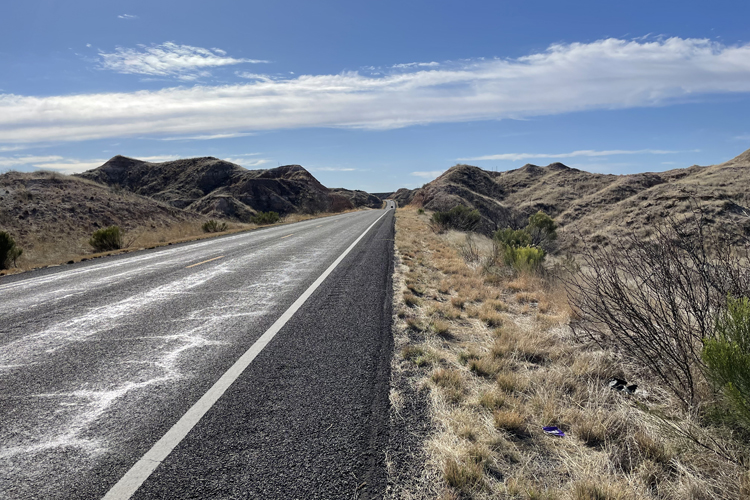
|

|
Then back on the bikes, but not before Dave-the-Younger was able snag a local root beer from the shack that had finally opened. Watching the show meant that the two Daves and I were last away for the 6 mile 1400 ft grind to the top of the hill. I was pleasantly surprised that I did not need to stop, and that I was able to more or less keep up with the two Daves. We re-grouped at the top before screaming down into Bisbee.
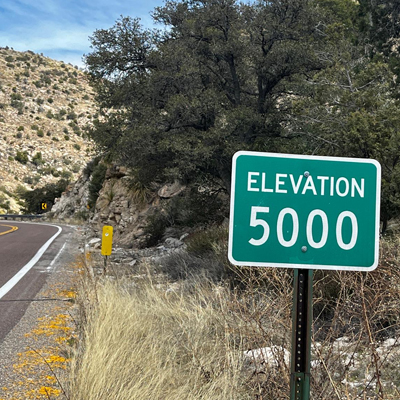
|
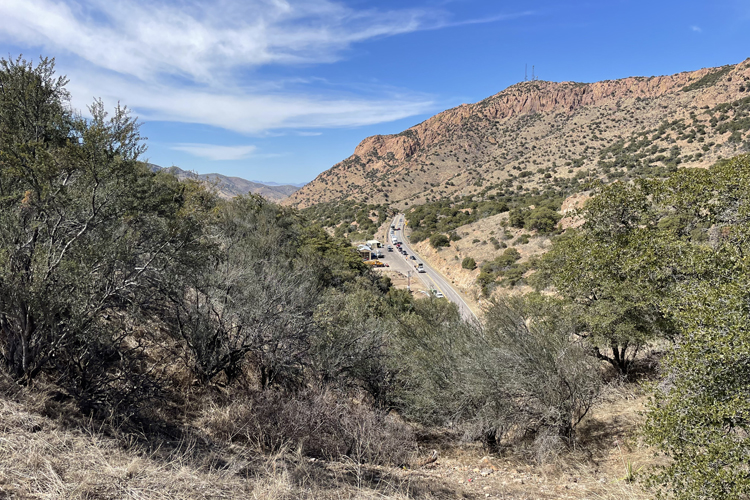
|

|
As we coasted into town Bobby flagged us down outside The High Desert Cafe and Market, across from the Iron man statue and court house, thereby allowing us to stop for lunch before continuing the final half mile coast down to the hotel. Lunch was slow but well worth the wait in a finally warm sunshine. Hearts of Palm Salad with Danish Blue Cheese, Pine Nuts, Moroccan Olives and Tomatoes on Mixed Greens. De-licious.
What a wonderfully funky place the hotel turned out to be. Constructed in 1906 and restored in 1986 in Old West Victorian style, the Bisbee Grand Hotel Bed and Breakfast is "an elegant escape back to the turn of the century. Each of our seven suites and six rooms is elegantly appointed with antiques, fine art, and extremely comfortable furniture. No two are alike and there is a theme sure to suit any taste." Among its other eccentricities was the room layout: my suite and Billy-Bob's were completely separate from the rest of the hotel with their own front doors right on the sidewalk
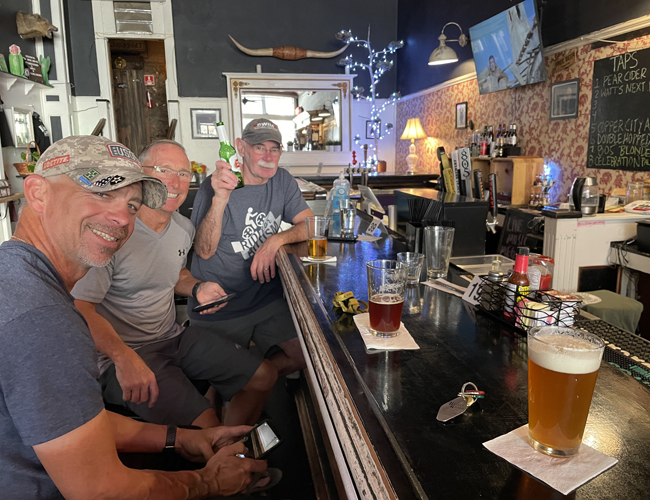
From left to right: Bobby (Cpt America); Doug; Dave-the-Elder |
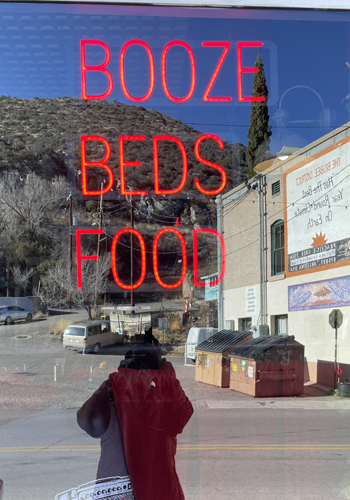
'nuf said |
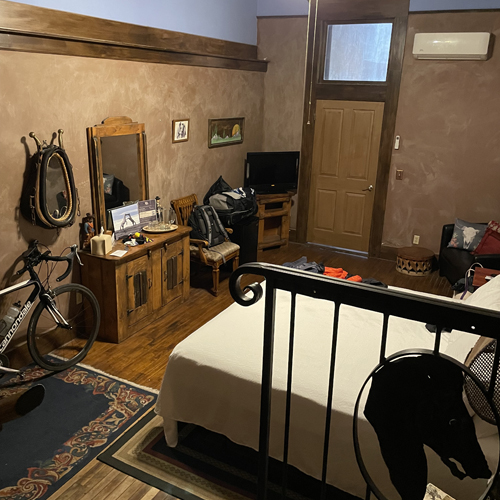
Old Western Suite |
| A bunch of us met in the bar for a couple of beers before dinner. I had Dragoon Double-Hopped IPA which was excellent, and Copper City Ale which was less so but still very drinkable and both nicely local. When we walked down to the restaurant they said it would be a 45 minute wait. We'd moved the reservation up an hour because we were all ready, so we asked it it would be better if we came back then? No, still a 45 minute wait. They only had three wait staff and were swamped. We voted to return to the bar, where they had NO wait staff, but were prepared to take our orders and cook for us right away. Bobby and Dennis did the bussing, and though it took a little while, we were still done and dusted by 7:15, which according to the original plan is about the time we would have been seated. |
Rooming list:
|
|
Bisbee Copper MineIn 1877, a reconnaissance detail of U.S. army scouts and cavalrymen was sent to the Mule Mountains to search the area for renegade Apaches. What civilian tracker Jack Dunn found instead were signs of mineralization indicating the presence of lead, copper and possibly silver. The first mining claim was staked in what would later become the City of Bisbee. The filing of this claim, and a multitude of others, sent prospectors and speculators scurrying to the Mule Mountains in hopes of striking it rich. Numerous ore bodies were located, and Bisbee soon became known as the "Queen of the Copper Camps." Bisbee proved to be one of the richest mineral sites in the world, producing nearly three million ounces of gold and more than eight billion pounds of copper, not to mention the silver, lead, manganese and zinc. By the early 1900's, driven by the booming mining industry, Bisbee had become the largest city in the Arizona territory. With a population of over 20,000 in 1910, Bisbee was one of the most cultured cities in the west. The town is still home to the the nation’s (arguably) oldest ballfield (Warren Ballpark), and was the site of Arizona’s first golf course (Turquoise Valley, sadly now an RV park). In better news, the state's first community library (Copper Queen) dates from this period, and is still in operation. Along with Bisbee's cosmopolitan character, the colorful, rough edges of the mining camp could still be found in the notorious Brewery Gulch, with its saloons and brothels. In its heyday, the Gulch boasted nearly 50 saloons and was considered the one of the liveliest spots in the west. Historic taverns still retain the rich character and boom-town flavor of this period. Beginning in 1917, open-pit mining was successfully introduced to meet the copper demand during World War I, and open and underground operations continued through to 1974 when with ore reserves depleted, Phelps Dodge curtailed open pit operations that year and ceased underground operations in 1975. With the mine closed, a tremendous shift occurred in the local population. As many mining employees and their families left to pursue work elsewhere, an influx of creative free spirits found Bisbee's historic district to be an attractive, inspiring, and inexpensive location to settle and pursue their artistic endeavors. Today, Bisbee is known as a culturally rich community that retains its welcoming spirit, offering visitors a rich mix of art, music, history, architecture, outdoor activities, dining and nightlife. I wish we had had time to visit the Smithsonian-affiliated Bisbee Mining and Historical Museum and the "world-famous" Queen Mine Tour of the underground world of the miners. Oh well, next time. |
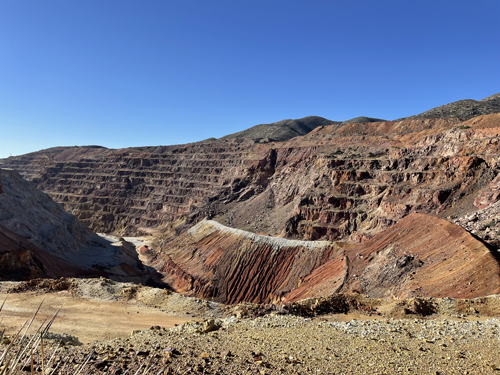
Tuesday March 14 Bisbee AZ to Portal AZ Elevation: 4760ft
Temp: 49f - 68f Ascent: 2674ft Distance 84 Miles
There followed three amazing days including a century ride, with the wind blasting from the west. We got a late start out of Bisbee because breakfast did not open until 8a. But by pre-ordering the night before (and Dennis and Bobby bussing/waitering again, everything was on the table by 8:10. On the outskirts of town, the road ran right passed the open pit mine giving us an awesome view (in both senses of the word)
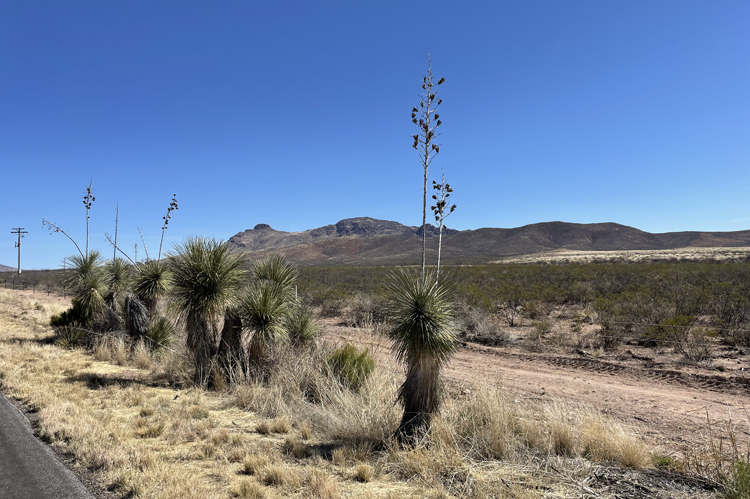
|
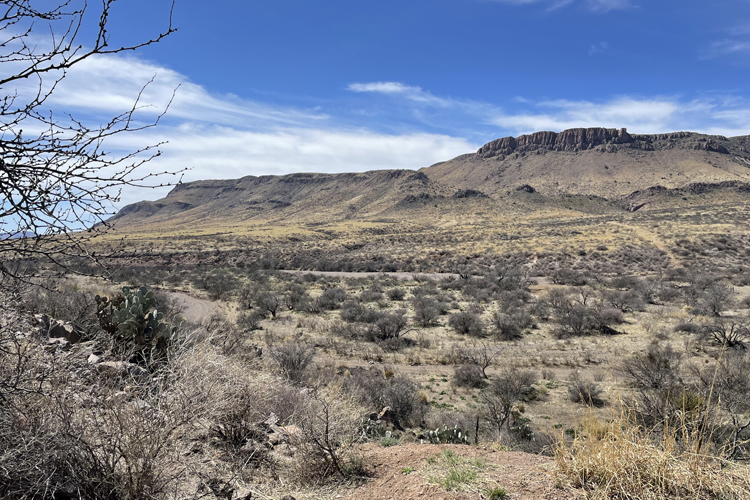
|
Wild ride today. 85 miles at least half of which was though completely deserted desert. It has been two days since we lost the highway and the train. Just Rt 80 in MFN (Middle of F🤬ing Nowhere). The horizon is always a low set of hills rimming the flat desert, like we are in a crater. We ride for twenty miles gradually getting closer and closer, and then suddenly we are up and over. Only to be presented with a new target exactly like the one before.
Wind singing in the overhead wires sounds exactly like a military jet.
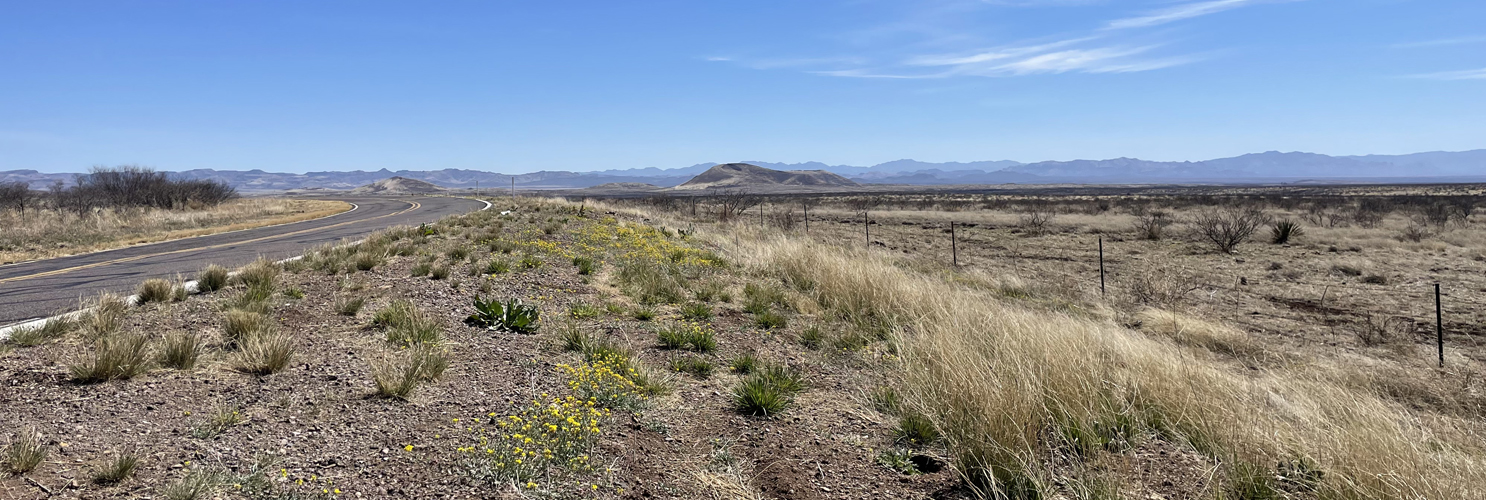
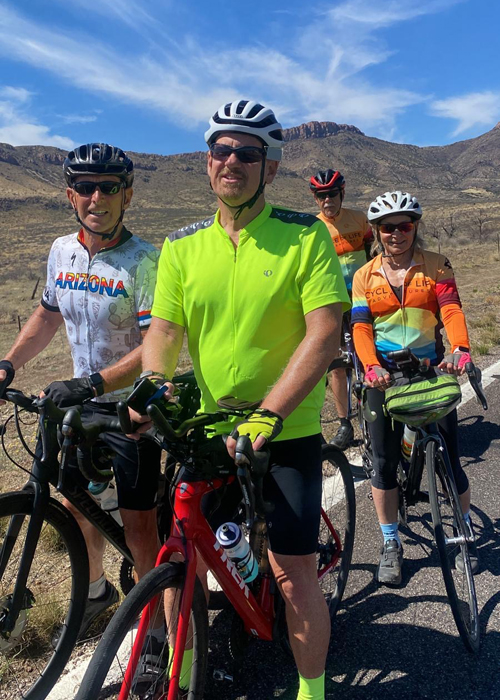
Left to Right: Doug; Dave-the-Younger; RT; Betsy |
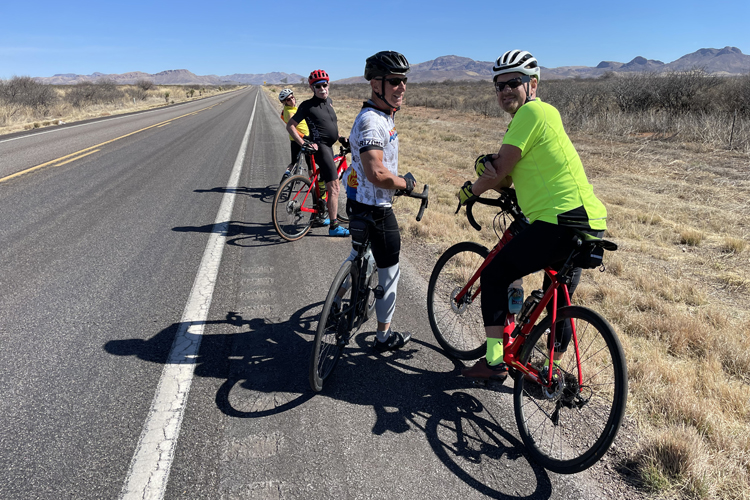
Back to front: Betsy; Dave-the-Elder; Doug; Dave-the Younger |
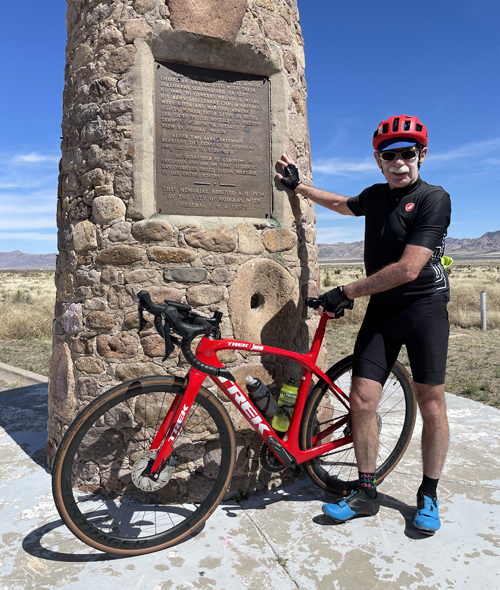
Dave-the-Elder obvi, posin' 'til closin' |
Hmm. This is interesting. These wonderful shots belong right here because the photo sequence proves it, but it clearly implies that this Big Dog B-team mix rode together for quite a distance. Where the rest of the Big Dogs are is a mystery and we all defo caught up together at Geronomo's Monument, so normality was restored, but this all speaks to what a homogenous team we really were.
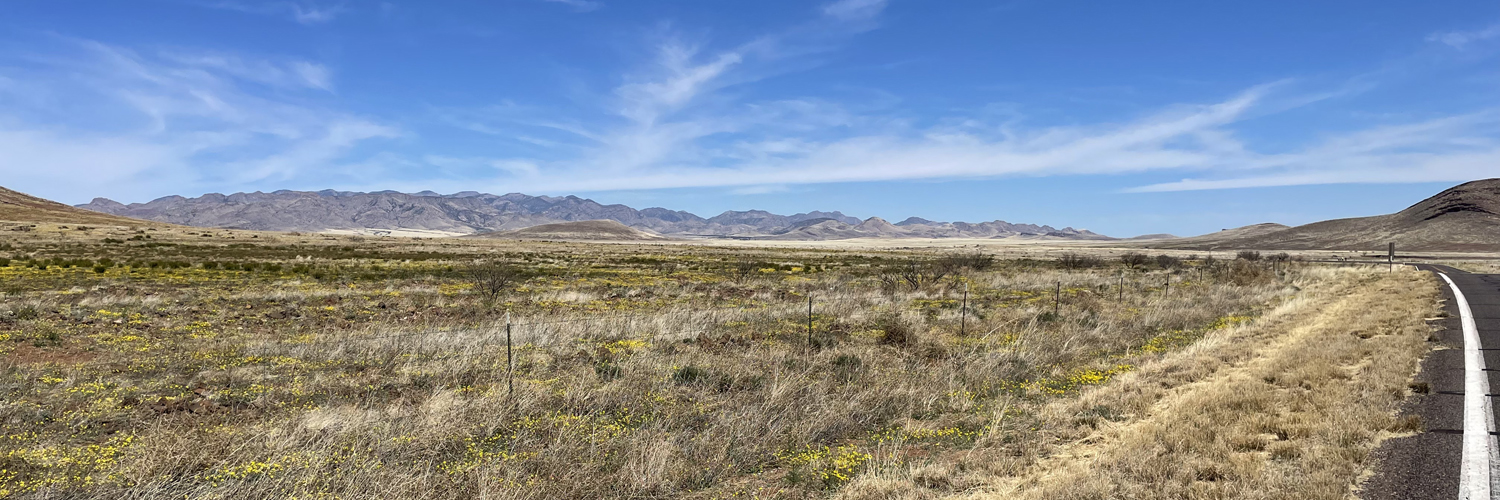
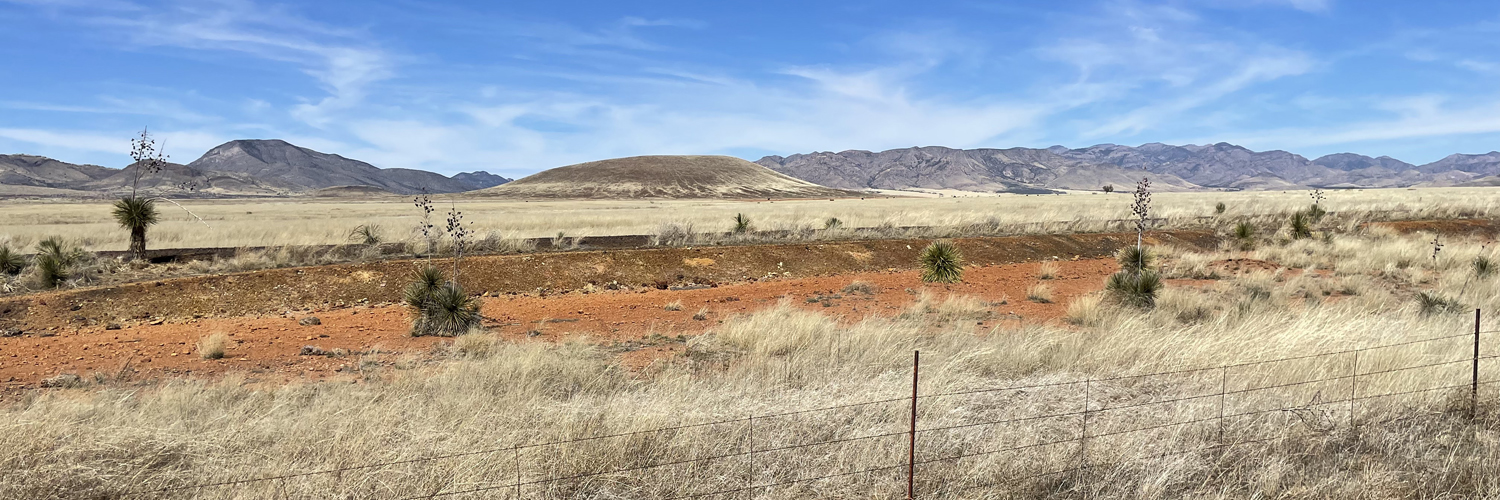
Geronimo's Monument: The other side of the street
Geronimo's Surrender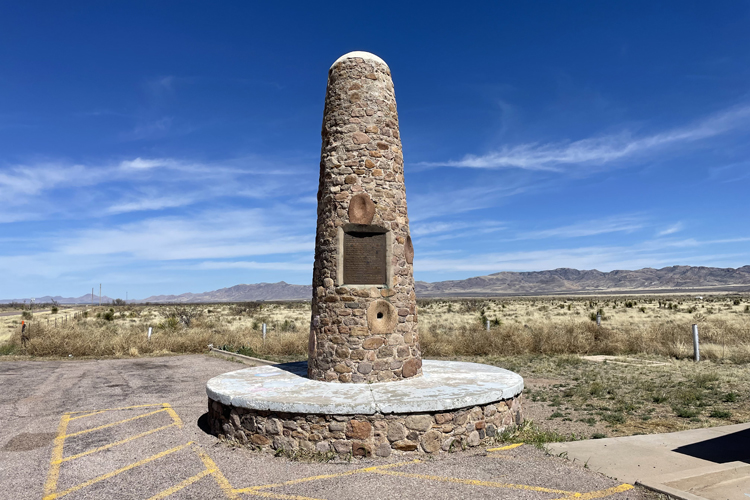 Geronimo was born in June of 1829 near present-day Turkey Creek, New Mexico (at the time it was Mexico). When he was 28 years old his camp was attacked by Mexican soldiers. He and most of the Apache men were away at the time and returned to see many of the women and children had been slaughtered, including Geronimo’s mother, wife, and his three children. This massacre set him on a path of resistance against the colonizing forces that sought to control and oppress the Apache. For several decades thereafter, Geronimo helped lead raids against incursions of settlers into traditional Apache lands. His guerrilla raids became notorious for their ferocity and efficiency, often successfully taking on units of soldiers much larger than his own. He frustrated pursuing armies by escaping seemingly hopeless situations and crossing back and forth across international borders to thwart his enemies. Geronimo and his group were finally tracked down and Captain Henry Lawton, a U.S. soldier Geronimo respected, was sent to talk with him. Lawton spoke the Apache language and respected their culture and customs. Geronimo allegedly saw Lawton as a formidable and honorable opponent whose word was trusted more than most soldiers. Lawton was able to convince Geronimo to surrender, and that he and his band would not be attacked if he agreed to do so. Lawton then escorted Geronimo and his followers to Skeleton Canyon where General Miles was camped. The pillar was constructed in 1934 by the Civil Works Administration, as one of President Franklin Roosevelt’s New Deal programs. It is eight miles away from the actual site of Geronimo’s surrender in Skeleton Canyon, which is on private land. The plaque on the pillar uses some questionable language to describe the events it commemorates, calling Geronimo and his band “hostiles,” citing the bravery of the U.S. troops without adding context or the Apache perspective, and falsely claiming that the surrender marked the end of U.S. military warfare against native peoples. Regardless, the pillar does undoubtedly marks an important event in history and the life of an extraordinary person. |
|
The most noteworthy attraction other than the outstanding beauty of the desert, was passing the stone pillar commemorating Geronimo's surrender to General Nelson Miles on September 6 1886. Then 10 miles later we hit the New Mexico state line, and at breakneck speeds, I averaged 22 mph over this last segment ending at the New Mexico state line. The big dogs did me the honor of letting me "pull" the team the whole way, eventually crossing the line first. I'm joking of course. Pulling is what happens in a pace line, and the big dogs were way too savvy to ride that close to me. But they let me stay out front anyway. Having crossed into New Mexico, we promptly crossed back into Arizona to spend our last Arizona night at Portal. The remaining 10 miles were not so pretty. The only time we turn westward, and everyone seemed to be dragging as if the backwards direction was applying additional resistance. The 500ft of "unnecessary" climbing definitely was. So the last five or so miles back to the motel seemed to take forever. As we neared Portal, I started to hear birds for what felt like the first time, and shortly thereafter lo, a B&B for Birders. Finally we were there. The place had an army barrack sort of feel to it: two typical motel one-storey, strip-mall rows, but here facing each other across a 15ft boardwalk. A couple of picnic tables in the middle of the boardwalk made a splendid Happy Hour gathering spot. It is frustrating that when we got to somewhere on Sunday, the bike shop or restaurant we wanted would be shut on Sundays. But when we get there on Monday, Mondays, are their day off. Now incredibly here we were on a Tuesday, and Tuesday is the day off for the only restaurant in this truly one-horse town, (it was actually attached to the motel). So kudos once more to Dennis, they opened specially for us (and another crew to be fair, so this was probably the busiest day of their week and definitely worth opening for. The Southwestern salad with chicken (lots of sweet corn and red peppers stirred up with chopped up grilled chicken) was delicious. The cherry cobbler had a more manufactured taste to it but was a welcome treat. Also nice that the iced tea was homemade and unsweetened. |
Left to right: Kevin; Betsy; Craig; RT; Dave-the-Younger; Dave-the-Elder; Doug; Steven 
|
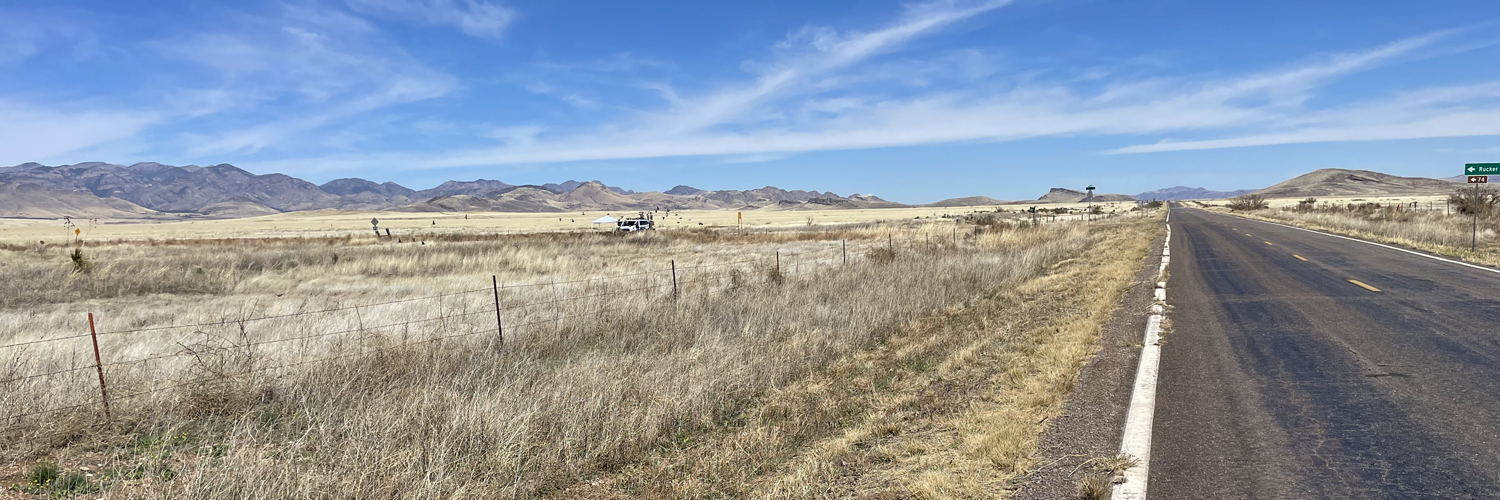

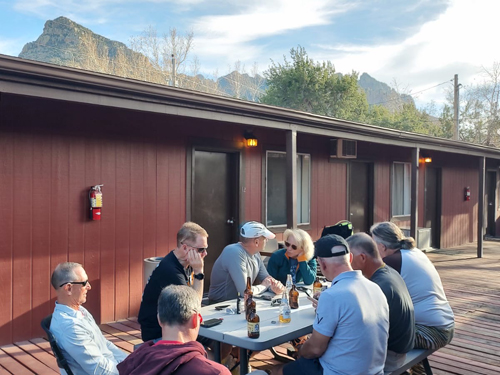
Dennis identified the crowd of folks queuing to pay as we were ordering as members of this rival crew, The Carolina Tailwinds. I asked him about the differences between the various bike touring companies. His synopsis of the two biggest: Timberline: "you sleep on gym floors, and camping in church yards. Oh, and you cook for yourself." Caroliner Tailwinds: "everyone has to ride at the pace of the slowest rider." Arrgghh! He also said you got some sort of (small) voucher towards the cost of the evening meal, regardless of the available options. So these were Tailwinders, all settling their individual bills. I congratulated myself once again for the wisdom of my selection, and the classiness of Cycle of Life.
Given how far we were from anything, and it was a warm night, I groped my way down the pitch dark road a little way until I was away from the motel lights in the hope of a spectacular starlight display, but no such luck: what I tried to imagine was the milky way was just streaks of cloud cover obstructing the view.
Wednesday March 15 Portal AZ to Columbus NM Elevation: 4050ft
Temp: 45f - 71f Ascent: 18937ft Distance 101 Miles
By contrast to yesterday morning's late start, Dennis had handed out our breakfast burritos as a night cap, because we needed to be on the road by 7a: it was already 8a in New Mexico.
As we suited up we chatted with John Selby, the owner of "Bass" the Bassett hound, who was loitering in the parking lot watching the spectacle. He turned out to be a mule breeder—who knew such a thing still existed? We invited him to join us: "If it don't have four legs and long ears, I can't do it."
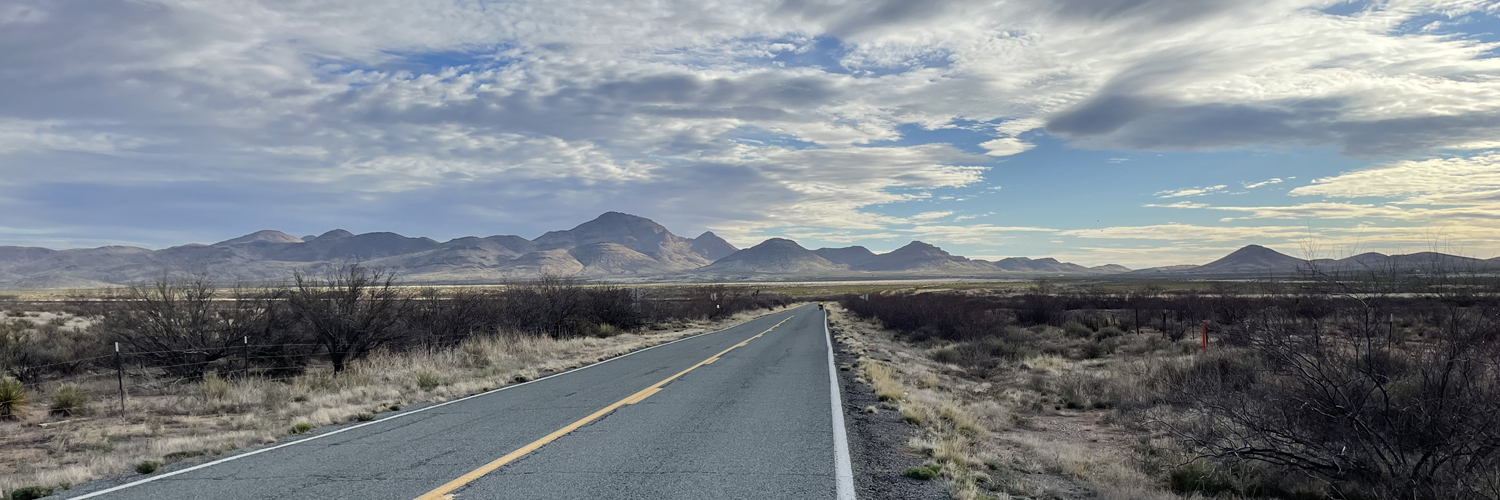
|
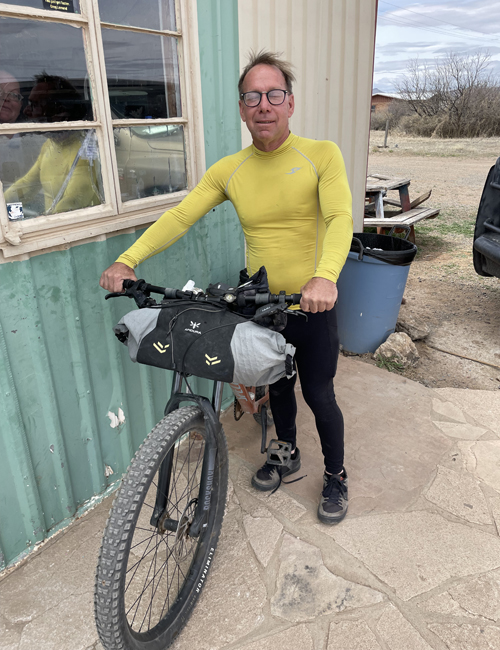
At a water stop at the Hachita Food Mart, we met Jeff Cullen a complete bike nut, who was preparing to do the Continental Divide off-road race. This piece of complete insanity is an ultra-endurance bikepacking race along the complete length of the 2,745 mile Great Divide Mountain Bike Route from Banff, Alberta, Canada and finishing at the US/Mexico border in Antelope Wells, New Mexico. The Great Divide Mountain Bike Route (GDMBR) itself is the most recognized and important off-pavement cycling route in the United States, if not the world. Might be fun but self-supported racing? But crazily, in this little town with a single-digit population count, Jeff was not the biking nut that Dennis had predicated would be there, and who would come out to chat with us. |
My favorite shots of Dave and myself were taken only hours apart. I like to think we each took the other's portrait, but I can't be at all certain about that. ... 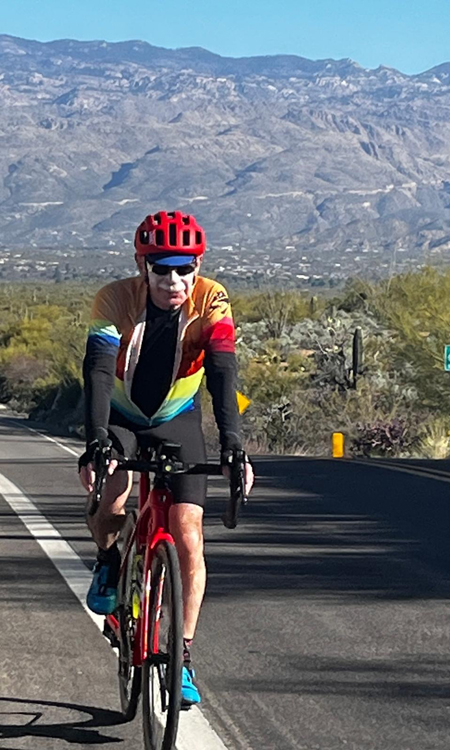 |
... Now that I study the images, I'm not sure that there is any basis of truth in the first statement either. Okay I just think they belong together. 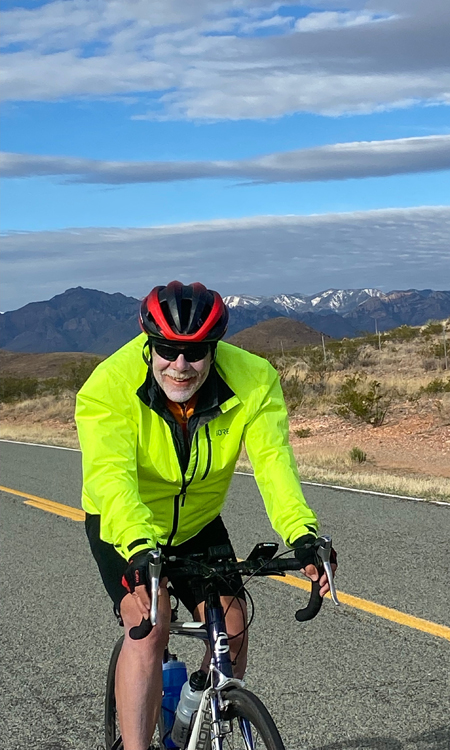
|
|
The Continental Divide facing east! 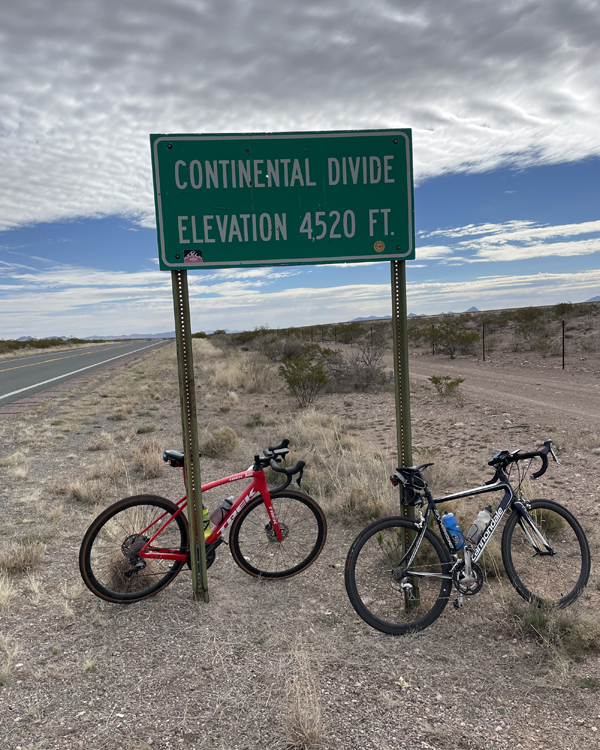
|
Ok, ok. Here it is facing backwards. West. 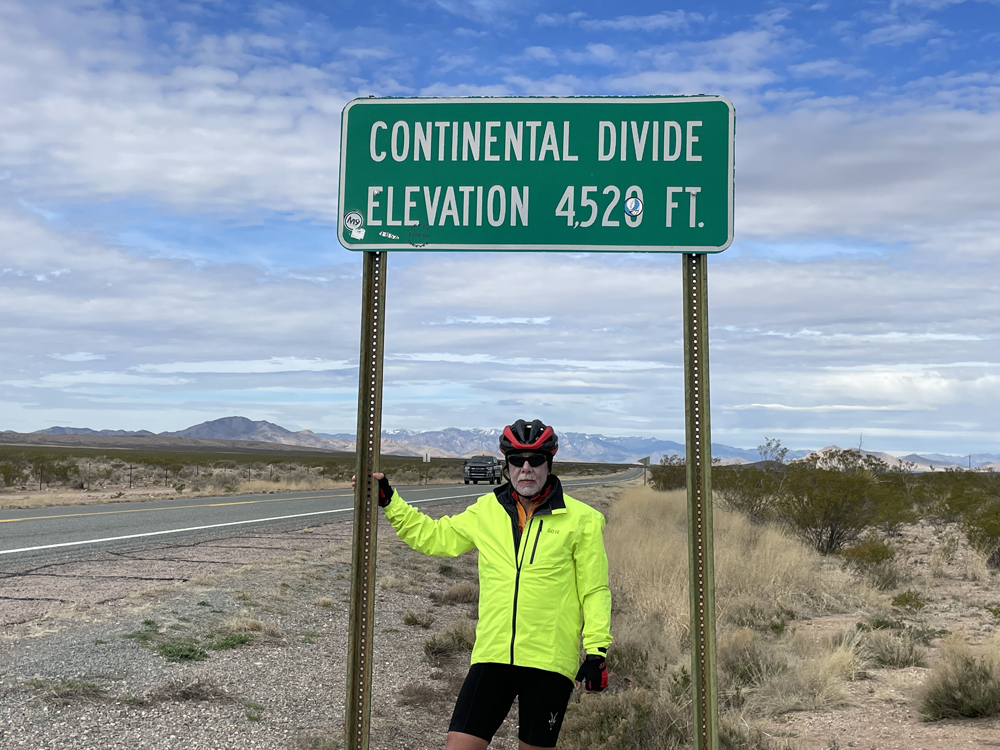
|
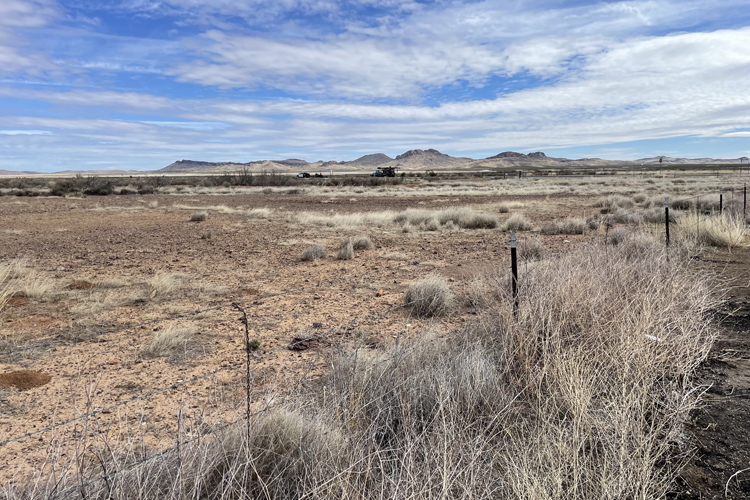
The Continental Divide (4520ft) was at about the 30 mile mark and about 700 miles into the trip. Unremarkable but significant. Now were were officially in MMFN (the Middle of the Middle of F🤬ing Nowhere). The shot with the bikes is the "official"one, with the camera facing east. The committee said the view west was much more spectacular (true fact) and we should use that but I couldn't. I think a life time of reading and watching movies/TV taught me left-to-right is moving forward, leaving home, right to left is going back. Looking straight is going forward unless there is evidence to the contrary, such as a mirror or the camera panning around. It makes a big difference: "I climbed this hill, I didn't coast down it!" We were travelling east, this is the continental divide, looking east, looking for Florida.
Betsy: "There were lots of border patrol vehicles, spotlight / infrared apparatus set ups, border stations, and barbed wire fences. In parts, the barbed wire and surrounding area was strewn with debris like empty water containers, Styrofoam boxes, and heaps of clothing articles that looked like they had been emptied hurriedly out of a bag—pink T-shirts, jackets, pants, children’s clothing. I couldn’t help but wonder about the circumstances around the quick abandonment of those belongings, as the items didn’t appear to be blown in from down the road. "
I too remember sad jetsam, and pondered on the same question. It was in this same isolated stretch that Bobby saw four immigrants rushing the border. Which is one reason why our crew are so keen for us to ride together. As if to cap off this picture of desperation and desolation, this was also where we saw our first and thankfully only, wolf road kill.
Dave-the-Younger must've been having an off day, because he was riding with the B Team when the team made an unauthorized pit stop. Ironically, but luckily, the real rest stop was less than a mile further, but that was where Dave realized that he had dropped his phone back at the pit stop. He headed off into what was then a ferocious headwind and by a miracle found the totally anonymous spot again. Meanwhile I frantically tried to find his number on my phone, hoping to call at the moment he was looking, but he had just picked it up when it started to ring. All good.
For miles as we approached Columbus we passed school bus stops in the middle of nowhere, and then on the outskirts of town by far the largest, and most modern building in town was a high school. Betsy, Dave-the-Elder and I rolled into town together and since this time we were just one mile short of the century it seemed unsporting not to join them to complete it. Columbus is a crossroads, and we wisely turned right rather than going straight on and then having to turn into the teeth of the wind to return home. It was vicious enough as a crosswind, a nice reminder of what a help it had been until then.
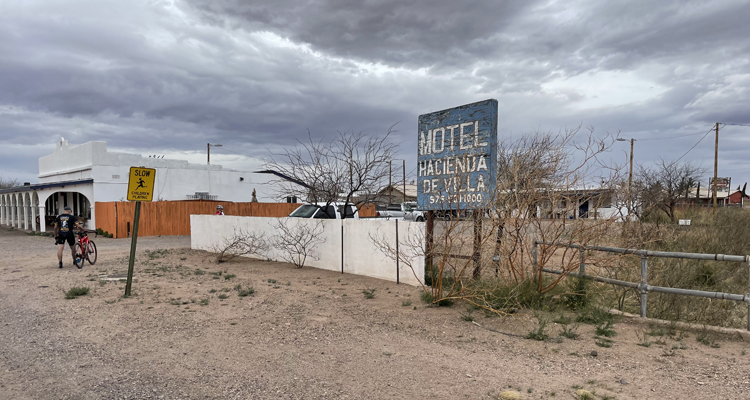
Columbus was yet another one-horse town, but we never explored Portal because the motel was the first building we came to, and we left the same way we came in. In Columbus we were split between the Los Milagros B&B and a (the) motel clear across town, or half a block depending on how you count. We also went to the diner for breakfast, which made it feel like we made use of everything that was open. Mind you, since the motel looked like it had been shut for year but it wasn't. I guess other places could have been the same.
The Los Milagros B&B owner made is a lovely homemade supper of green and red enchiladas with rice (a delicious rice, peppers, and cheese mixture moulded into a tower using a small glass). And homemade cheesecake for desert. But IMHO best of show went to the salsa and chip starter, of course also homemade, but the salsa was this interesting mix of red and green ingredients. Perhaps it had cactus or something but it was unique and had a curious after burn—not hot at all in the mouth and then it crept on you. Outstanding.
I talked to what I assumed was our hostess's father about the school district (and he turned out to be a bus driver). The catchment area is about 30 miles, which extended into Mexico itself. The school catered to Native American kids as well as the American kids who lived across the boarder (most of whom had Mexican parents who had been deported. When questions about paying these kids who by definition could not have been paying taxes, local or federal, the old man explained that the powers that be had done the math: pay now or pay (much more) later.
Our bikes were outside in the motel compound, so of course this was the night it rained. I crashed at 8p and never noticed.
Thursday March 16 Columbus NM to El Paso TX Elevation: 3740ft
Temp: 53f - 64f Ascent: 764ft Distance 69 Miles
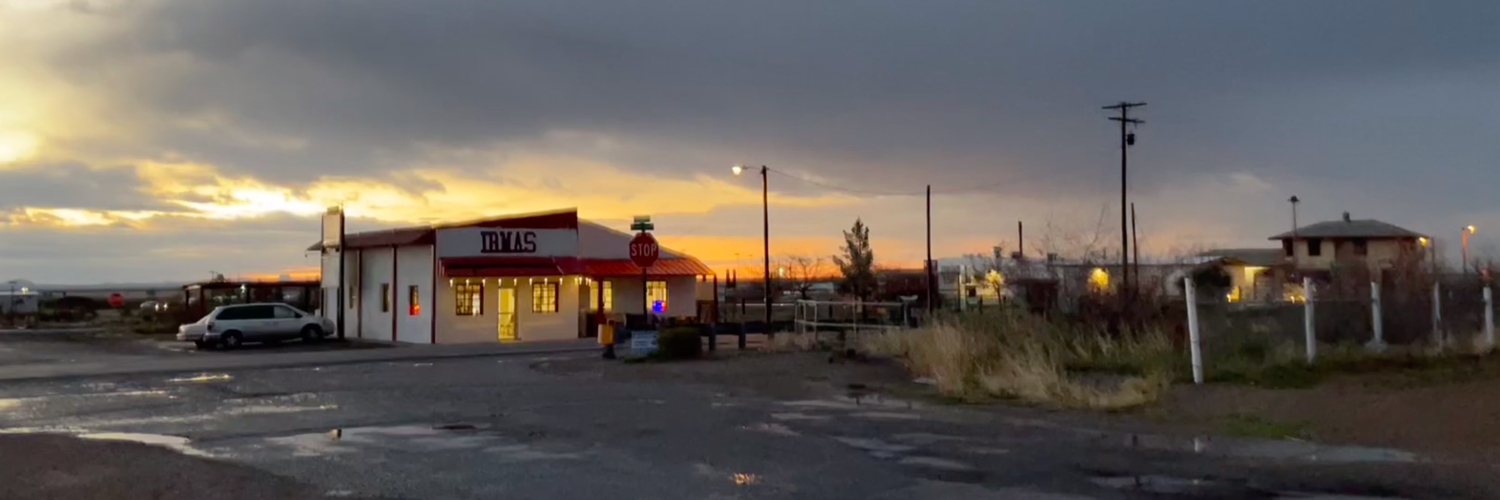

There were a whole chorus of roosters crowing in the damp pre-dawn morning. Given the tiny population it seemed like every family must have had one. They certainly added to the rustic atmosphere.
Having lost another hour, light was just breaking as we walked over to breakfast at Irma's Diner. Irma recommended Mexican Eggs. RT: "Does it have chorizo?" Irma: "Nooooo" in a tone that said "tchu crazy gringo! how can you even ask?" Instead she said "Order chorizo and eggs if you want that"
Three straight days now in the middle of the middle of nowhere. No highway and no railroad for company, and the traffic has slowed to a trickle: one vehicle every five minutes or so. It is remarkable how much this seems to relax things. That and the tail wind means that you can just trundle along without a care in the world.

Today we seem to have perfected the routine after another very diplomatic slapping from Dennis last night. Bill agreed to, and this time actually did, set out 15 minutes earlier than the official start time, and the rest of the gang set out 15 minutes after it. I, as the next weakest link in the chain, set off a few minutes in front of the front of the remaining pack. In part because of the easy terrain, and the wind, at the first water stop, Bill and I were still in front. He'd already left and I left first again as every one else caught up. By the second stop, everyone had caught up, but by then we were 30 miles into the ride. The net result was that Bill was around for lunch, and everyone finished fairly close together—which of course was exactly what we wanted.
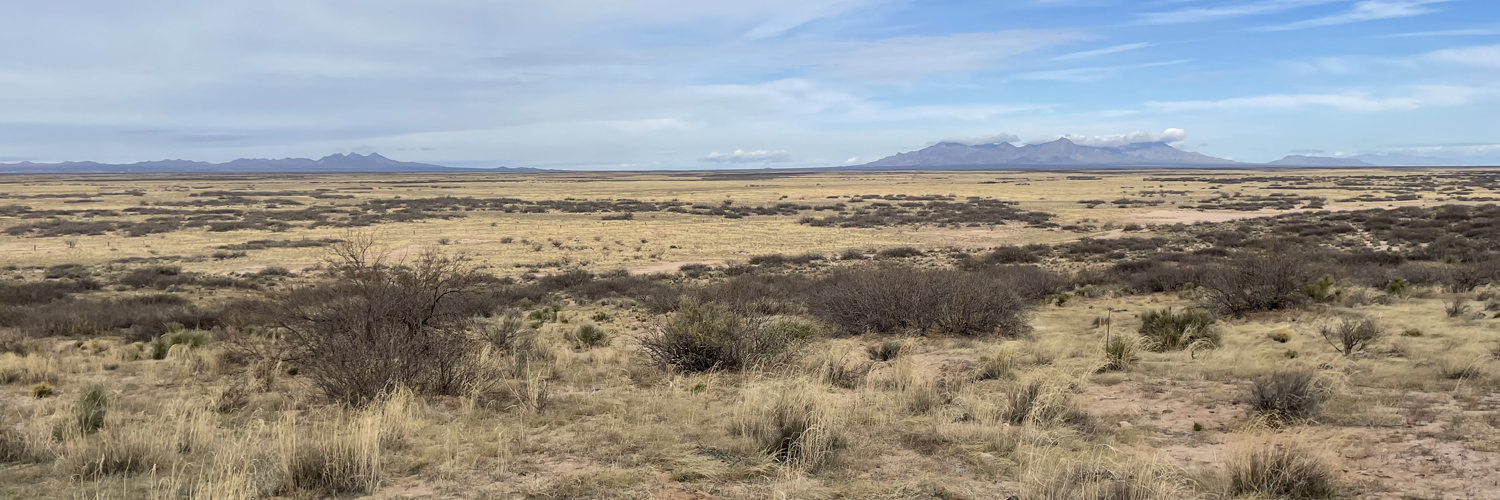
As we reached the outskirts of El Paso I was looking forward to the next big river crossing: the Rio Grande. This time, to my horror, I actually did miss it and turned around to find it after I started heading uphill again and realized something was not right. Something was indeed not right. It was just a dry sand bed threading through the city. But Rio Grande it was, and that meant Texas! Or Tex-Ass as Dennis' dad Skip prefers to call it. Pernicious IPA from Wicked Weed Brewing. Happy hour I think, because not the brewery or dinner. Bill needed his bike looked at, so there was a trip to the "Trek Bike Store" and a bunch of us went along for the ride. The shop was a bit too flashy for me—all spick and span and open spaces, instead of full of interesting toys and tools. A show room not a bike shop. By some miracle, there was a brewery right next door, so I waited there. Cold IPA (that was its name, not its condition: it was brewed like a lager) was unusual and tasty. Despite telling me that "that's executive level thinking" when I suggested that he buy us all a beer while we all wait for his bike to be done, Bill was still the last to get there and since I already had an open tab, it seemed churlish not to add his beer to it. |
Like the Colorado, I would have missed the Rio Grande if I had not been looking for it specifically. This time no water at all! 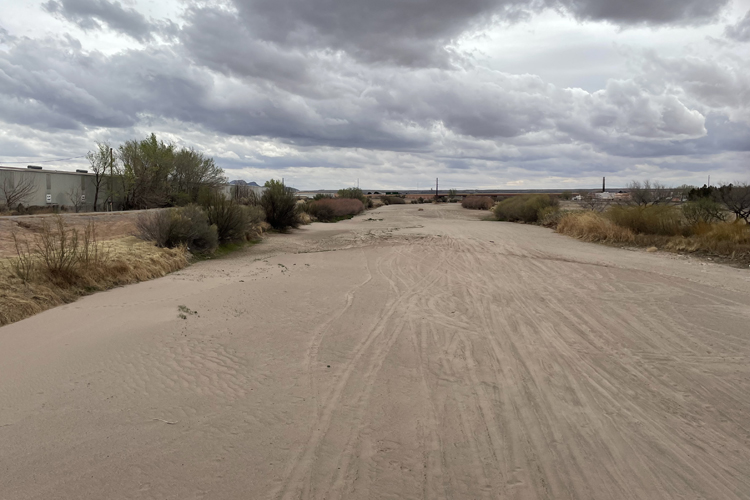 |
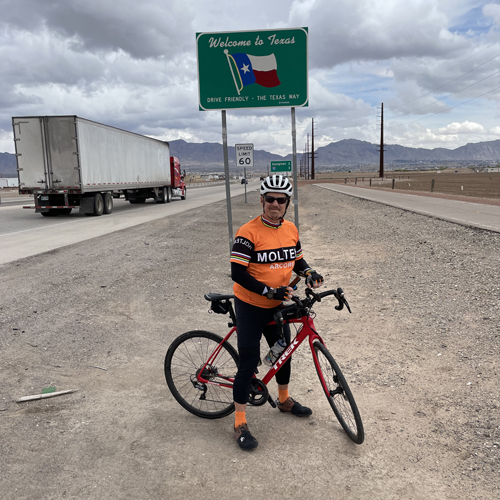
We stayed in the very far north of El Paso, and went even further north to dinner because Dennis wanted no part of downtown El Paso and the tensions caused by the immigration crisis that has new arrivals camping on the sidewalks and in the city parks.
Texas: so first steaks of the trip! This new regime seems to have transformed Bill too. I for one was effusive when I came by him on the ride, letting him know how great I thought it was that we were both in front, and I'm sure others did the same. But he might also have realized the even the whiff of a feeling that he was part of a team felt better than he ever imagined. At the Great American Steakhouse—first night in Texas, gotta have steak—he was the life and soul of his end of the table. I was still struggling with him so was happy to be at the quiet end. Anyway, he still regains a point for his change of attitude today. I had fillet minion, mash, beans, coleslaw, and baked jalapenos. Good but not the best I'd ever had, though that could easily be more the result of trying to get a dozen plates to the table simultaneously than a general problem with their standards. The Sante Fe Happy Camper IPA was similarly unenthusiastic.
I'm in West World: Cycling Edition. The "real world" of our lovely new grand daughter, work, the winter weather in Massachusetts, not to mention Claudia, the pups, or an average evening watching TV, are all a distant memory that I assume (hope!) I will pop back out into when this is done but for now feel as imaginary as I suspect West World will be once I get back. I haven't listened to any music, watched any shows—they all seem unable to grasp my interest, if not downright inappropriate. The only book I can pick up is the one Joel gave me on "The History and Mystery of the Bicycle." Dinner conversations are the same. When someone used the Shiner Bock beer Craig ordered as a conversation stub about Armstrong, (for whom "as a native Texan this was a favorite beer") and how much he'd enjoyed reading Armstrong's biography, I followed along with great interest for some time before I realized we were talking about Lance, not Neil.
70 miles today and again crazy easy with 20knot tail wind. 19.6mph. In Peloton terms Resistance 35, Cadence 85, 22.5mph. Bonkers. After three similarly lovely days that I feel like I enjoyed every minute (finally, after worrying constantly about one thing or another. from the new distance, to the elevation, to my ass ...). But now I'm back in serious worry mode. The temperature is dropping alarmingly. Tomorrow is likely to be in the 40s, and is a long climb (6 miles, 1400ft) followed by a lot of city-type traffic. The cooler weather is the concern, but we are going to set off much later (as late as 10a) so it should be manageable. The real worry however, is the next day. Colder again (mid-30s or worse) and it is 105 miles, there is a pretty serious climb in the middle, and worst of all, rain is forecast. There is even talk of snow. And let's not forget many of us, myself included, have shipped our cold-weather gear home already. Gulp.
Friday March 17 El Paso TX to Clint TX Elevation: 3638ft
Temp: 45f - 58f Ascent: 2726ft Distance 51 Miles
By morning, the weather is a little better that predicted. A degree or two warmer (which makes a huge difference) and no rain until much later Tomorrow, the big one, is similarly improved, but the 15 knot headwind that is currently predicted could still be a deal-breaker. Meanwhile today, one step at a time, we are not setting off until 10a, firstly to get another degree of warmth and secondly because we cannot get into our rooms in Clint until 3p anyway, so there is no point in arriving any earlier. Between our early arrival yesterday, and our late departure today, it has almost felt like a rest day, with most people getting laundry done which feels good too. Dave-the-Younger and I were first to the only one machine, so we threw everything in together. Worked great. We even used the drier!
Today was all about getting around El Paso. We started in the north west corner, and ended in the south eastern corner ready to strike out into Texas in the morning.
The Pass at El Paso
The Pass at El Paso is a six mile 1400ft climb over Franklin Mountain from West El Paso to East El Paso. I now realize that my loneliness on the first day's long afternoon climb was not because of any difference between my abilities and those of the rest of the team. There is no peloton or pace line on big ascents, everyone just grips their handlebars between their teeth and cranks at their own pace. As we approached the base of the climb, I happened to be fairly near the front, only (I think) Dave-the-younger, Craig (obviously), and Billy-Bob who had set off much earlier. I knew I had no choice but to keep cranking. I feared that if I stopped I might physically not be able to start again on the steep gradient, never mind the mental collapse.
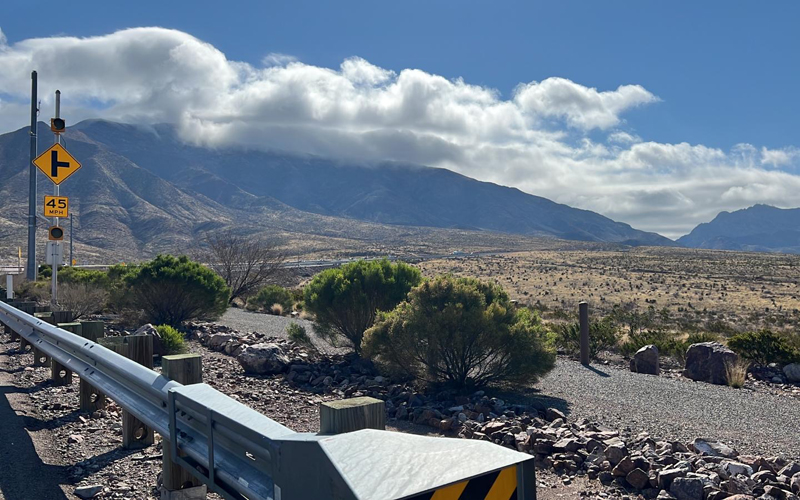
You can just about make out the road cutting across the center of the pic, heading for the pass ... |
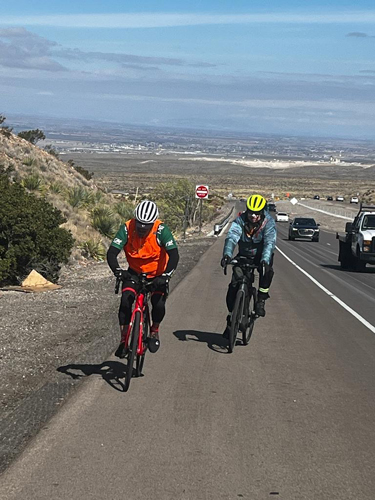
... Dave-the-Younger and Steven battling the slope and the wind ... |
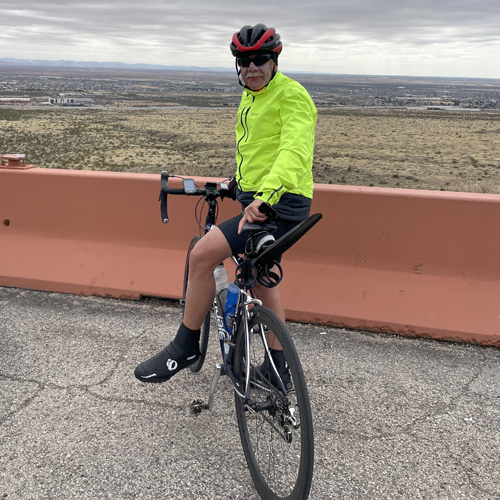
... RT freezing his buns half way down. |
If Dave was in front I must have passed him fairly early on, because I don't remember him re-appearing in the story until much later. About two miles in, we caught up with Billy-Bob, who was re-examining his breakfast as Bobby loaded his bike into the trailer. He later claimed it must have been something he ate, or perhaps last night's Margherita was too big/strong, but I'm not buying that.
The 18-wheelers on one side and the cliff on the other side of the jersey barrier provided a serious mental challenge, but the truly scary part was the cold and the buffeting 30mph cross wind which threatened to push you under the 18-wheelers, or suck you off the side of the mountain multiple times per second. Dave-the-Elder very wisely hitched a ride in the van.
About a quarter miles from the top, to my amazement I caught up with Craig and was forced to pass him as he was momentarily blown to a standstill against the barrier. As he caught up again we were nose to nose over the summit: "You are one tough M😡-F🤬". The ultimate compliment from the undisputed Top Gun was a crowning moment of the whole trip.
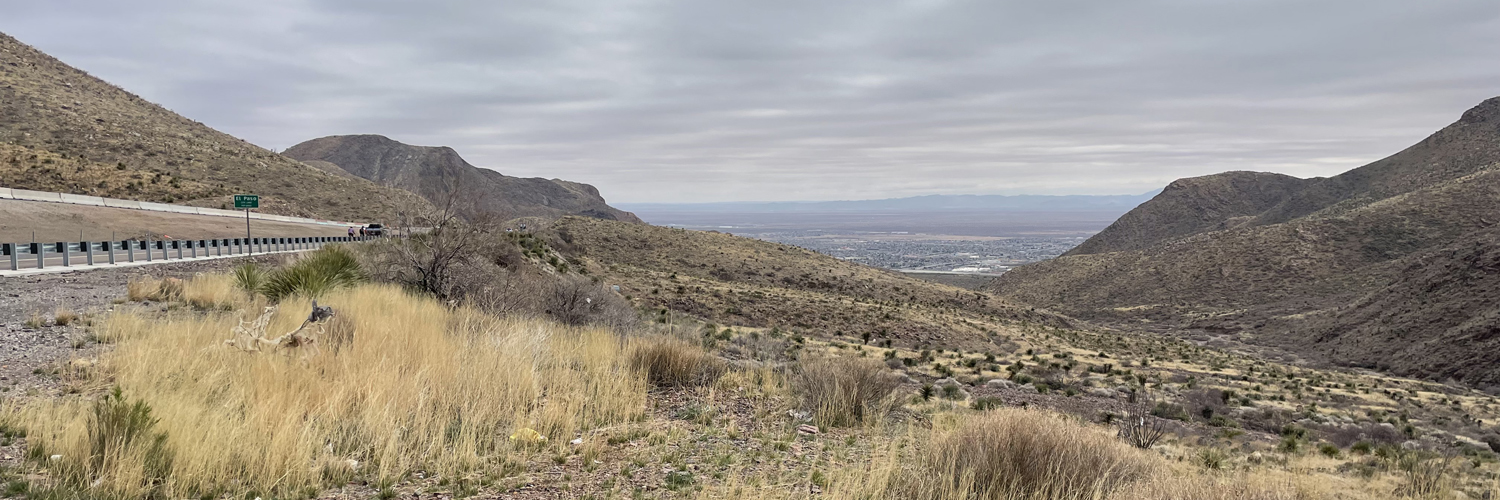
.Half way down again, the view to the bottom.
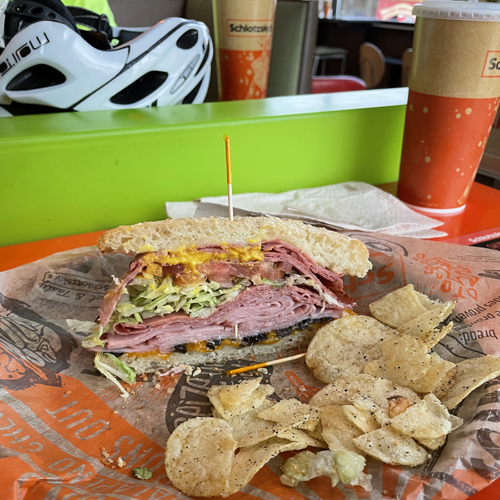
But of course the battle is not even close to over. Descending is obviously not as tough, but it is even more dangerous. Now the 18-wheelers were doing 70+ mph, and their backwash added significantly to the turbulence. Any speed you gather provides a multiplication factor to the seriousness of an accident. Last but by no means least, now cold AND sweaty, hypothermia is not out of the question. Needless to say then, the descent was slow, nerve-wracking, and very, very, cold.
We were so cold in fact that we peeled into the first strip mall we came to looking for somewhere, anywhere, to warm up, and hove to next to Hilda’s Tamales Restaurant. Hilda made large cups of the creamiest Mexican coffee (a first for me) and it was delicious! As the coffee warmed us we answered Hilda's obvious questions: "tchu guys are crazy!" Crew: "Yes we are ma'am."
Schlotzsky's in East El Paso because too cold for picnic. Deluxe Original (twice the meat) ham, salami, 3 cheeses, olives, onion, lettuce, tomato, mustard, signature sauce, on sough dough.

The middle third of the ride was all left and right turns through suburban East El Paso, and as advertized, full of dogs, but only two of them were loose. The little guys came into the middle of the road, then stopped short.
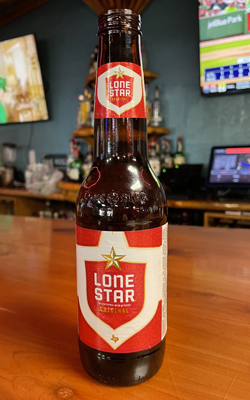
Finally a short third out into the countryside once more with orchards on both sides of the road. Membrellos (quince) and pecans are local crops / products, so I'm guessing the many orchards were either or both of those. Cajeta is a major export that I have not heard of since I was a kid and my grandmother made it. Less exotically back then it was known simply as quince jelly.
The train is back. For once, heading east. I gave the universal symbol, and the engineer rewarded me with a blast. Sleek (read: expensive) ponies then cows and calfs populated the well-manicured fields and paddocks.
Mamacitas Mexican was a one hundred yard walk from the hotel in Clint. An Appleby's / 99 kinda place, but that is absolutely nothing to be ashamed of. Same friendly staff, nice atmosphere and hearty food. As the first one to the bar, I felt totally welcome, and very American, as I nursed a Lone Star beer while I waited for the rest of the happy hour crew. Dinner was a Chile Rellano plate: 2 long green peppers stuffed with muenster cheese and flour tortilla and more Lone Star. Not my favorite beer, but totally appropriate, and I loved it for that.
Far Right: Out of my hotel window in Clint.
Saturday March 18 Clint TX to Van Horn TX Elevation: 4042ft
Temp: 43f - 46f Ascent: 801ft Distance 52 (105) Miles
Today wiped the smirk off my beak, and everyone else's. Hail as we set off at first light added to the misery of the 15 to 20 mph head/crosswinds. Rest stops increased, as did the time spent in them, with most folks piling into the van with its heater set to Sauna until the order to get back on the road. After 52 miles and 6.5 hours we rolled into the Traveling Tiger Center - Texas 87 Truck Stop and Travel Center in Sierra Blanca, and at the junction with I-10. In addition to that mouthful, it was also a Mexican Restaurant. At that point we were only half way and now we were going to be directly into the wind and 10 miles of uphill. Dennis ordered us to order lunch in the restaurant so we could get something hot inside us and to warm up generally. The entrance was through an enormous, empty souvenir shop. A perfect spot for the opening scene of a teen horror flick.

Just before the gas station
The restaurant looked similarly sketchy, but was excellent. As we were eating, Dennis the ref called the game. Doug got up and hugged him. Nobody complained. Like a firing squad, whose purpose is to make no one individual responsible, having Dennis make a collective decision meant no one individual had to give up, or be responsible for others giving up. I was amazed at how easy this was, and how relieved I was personally that I was done. I had listened sympathetically to Dennis's impassioned speech on Day 0 about Every F🤬ing Inch but it was lip service. Secretly I was keeping a private log of those I had personally disqualified from "truly" completely the ride due to some infraction or other. But right here, as we were all disqualified, I saw the light. I saw it so brightly that I never gave the idea another moment's thought.
Dennis (mostly) and Bobby loaded bikes into and onto the trailer and the van while we finished eating, and then we hit I-10. The first ten plus miles were the best, as the fully-laden van toiled up the thousand foot climb to the foot of Sierra Blanca a striking and beautiful bald mountain just north of the highway. As a bonus we got to be questioned by Border Control because for once we were traveling in the same direction as would-be aliens, and because we were in the van and not scooting around the traffic on our bikes. The officer asked Dennis if everyone was a US Passport holder and that was the sum total of the interrogation. Dennis's honest face must have done the trick, because otherwise we were a suspicious looking (and smelling) gaggle of predominantly male and unusually fit passengers who might quite reasonably have aroused the curiosity of a bored Border Patrol Officer.
|
I loved the El Capitan Hotel that night and could quite happily have spent several more days hanging out in its retro space. The lobby had "European tile on the floors and stairwells with finely crafted wrought iron banisters and exposed Spanish vigas lining the fourteen foot ceilings". Designed by famed architect Henry Trost, the hotel was built in 1930 by the Gateway Hotel Chain, led by Charles Bassett, at the crossroads of the forthcoming Carlsbad Caverns, Guadalupe and Big Bend National Parks. (There are three great reasons to go back.) |
Dinner was of course a stand out, not least because it was only 50ft from out rooms. But it was a lovely setting, same rustic tile floor, heavy oak tables and chairs. Because I hankered for a carbo loading, I had Penne Florentine with Alfredo sauce, red onions, spinach, Parmesan cheese, and diced tomatoes. Otherwise I would for sure have had the more appropriate to the location Chipotle Raspberry Pork chop.
Also memorable was the quote at the top of the menu. "This town is so healthy we had to shoot a man to start a cemetery." A. S. Goynes. Goynes was shot in front of the hotel. He was the first person buried in the local cemetery.
Sunday March 19 Van Horn TX to Fort Davis TX Elevation: 5050ft
Temp: 28f - 46f Ascent: 2503ft Distance 80 Miles
Then the final 80 mile day to Fort Davis: 45 miles uphill into the wind followed mercifully by the final 35 as a cross wind and some protection from the hills.
I was ready to go at 8a (departure delayed until 8:30 to allow the temperature to rise a degree or so) but I was ready, and pacing the foyer over thinking everything. Balancing the cold against the fact that the wind was only supposed to pick up at some point in the morning. So the earlier we got out, the more miles we'd make before the wind picked up. I got permission to roll, so roll I did.
Dave's movie of me "dressed up"?

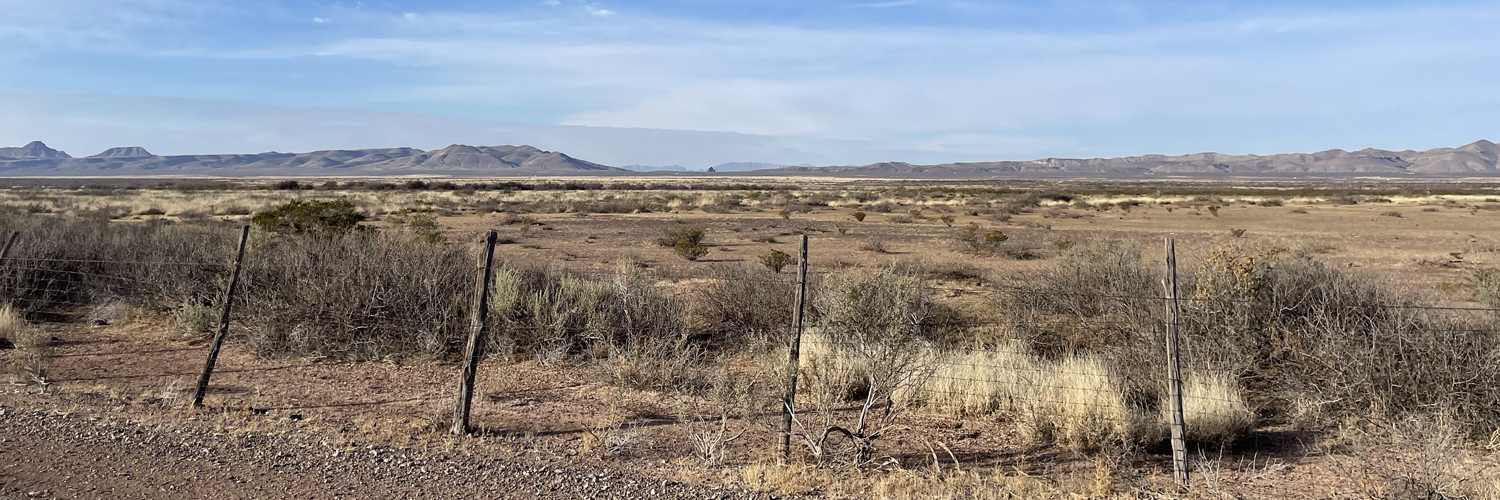
The weather was better in that it was not snowing, so it was actually quite nice for the first few miles in the sunshine. I even stopped a couple of times to take pictures. The first 45 miles was a dead straight, slight but relentless climb, and the wind took a couple of hours to pick up but then it was right into our faces. The "Prada" pit stop was surreal. In the middle of nowhere, a down-town cube of a building, with the roadside wall a glass store front and door, and in the window dozens of Prada shoes. It was a store that never opened, a work of art. No really. The whole thing was set up as a work of art. Several people stopped, took selfies, and drove on even in the few minutes I was there. I was warned that I was still a long way (too far) ahead of the pack, and I was held for a few minutes, but I needed to keep going.

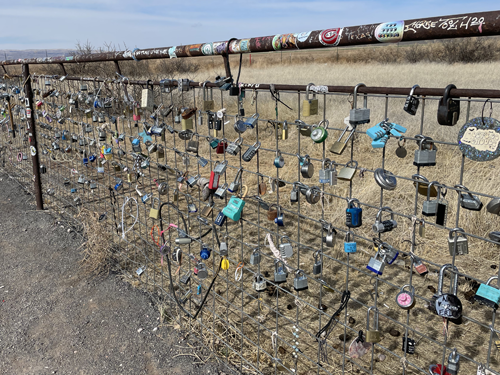

The wind continued to rise. Every time I looked up the view was exactly the same. It looked like the summit was a quarter mile ahead, but it never was. At one point I glanced down at my computer and I was barely managing five miles an hour. The last two miles seemed to take an eternity but at long last the left turn finally appeared. Once we turned off the main road, things improved considerably (side winds, some cover from the hills and the last 15 miles were down hill). But it was still cold. 30F when we set off, 45F at the end. 2500ft elevation gain, and 5900 ft at the top of the climb, the second highest point on the trip, and again like the first day, remnants of snow here and there.
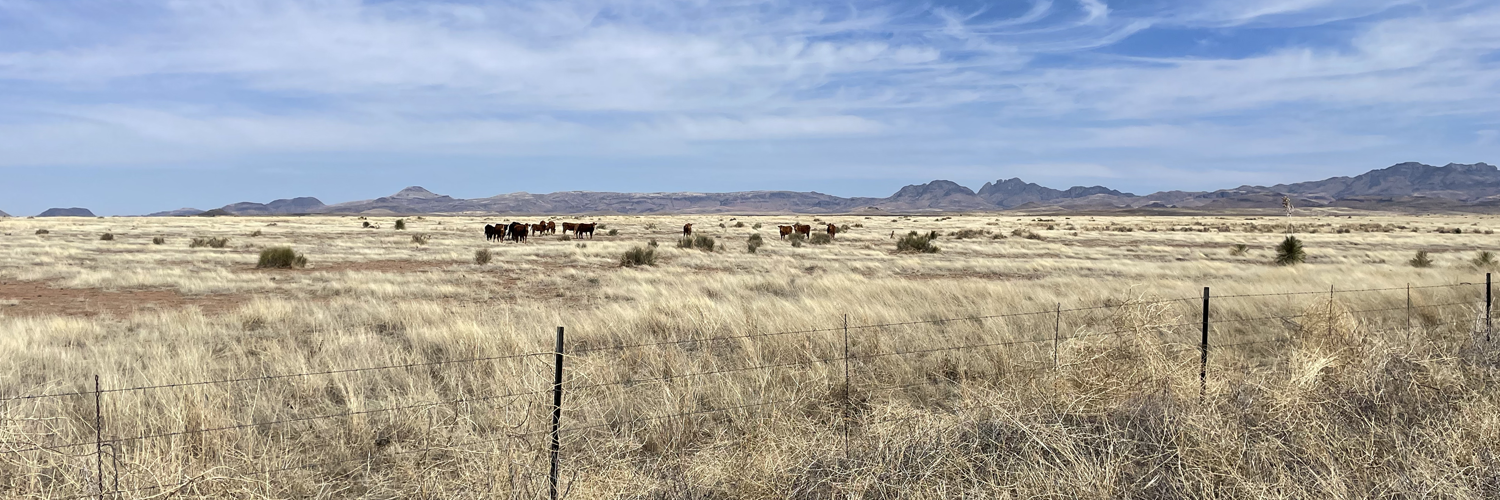
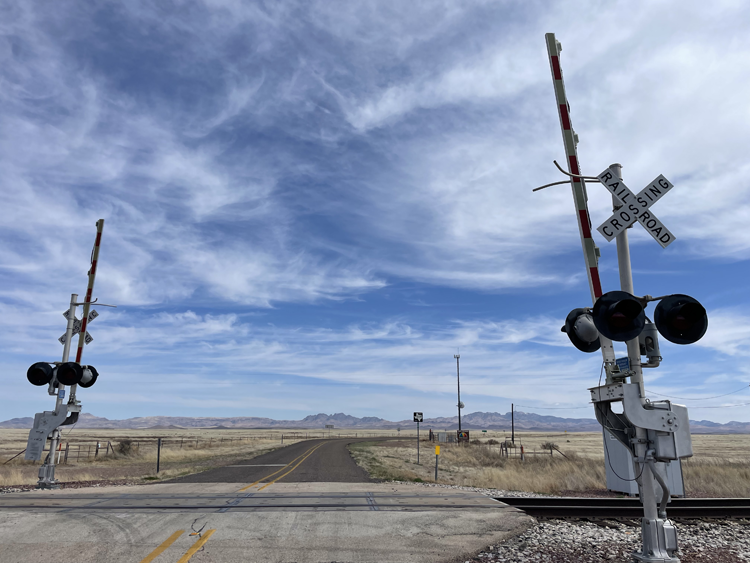
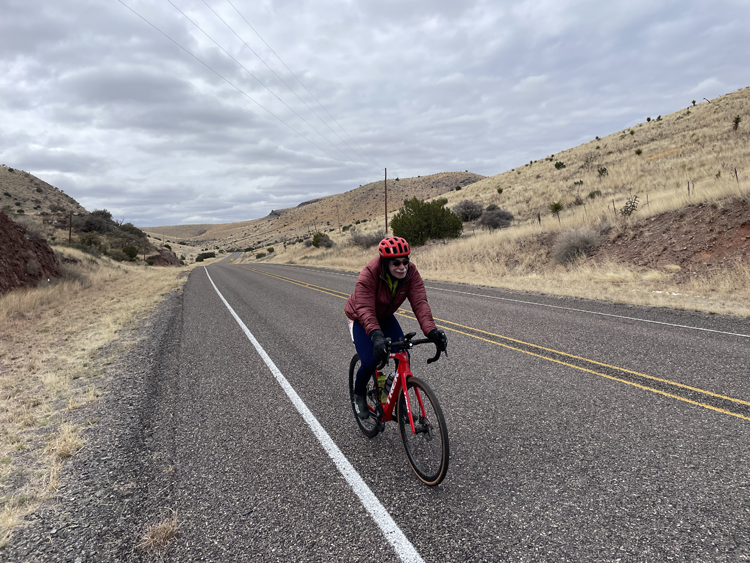
Nobody passed me all day, and apparently nobody even got close. Poor Dave-the-Elder got two flats, and was on the point of quitting because he was also still so tired, so he got a ride to the front: the lunch stop, about 30 miles from home. Therefore he was there as I pulled in, still so far in front that Dennis was clearly unhappy with me, but what was I supposed to do? We ate lunch and then Dave and I rode together for the rest of the afternoon.
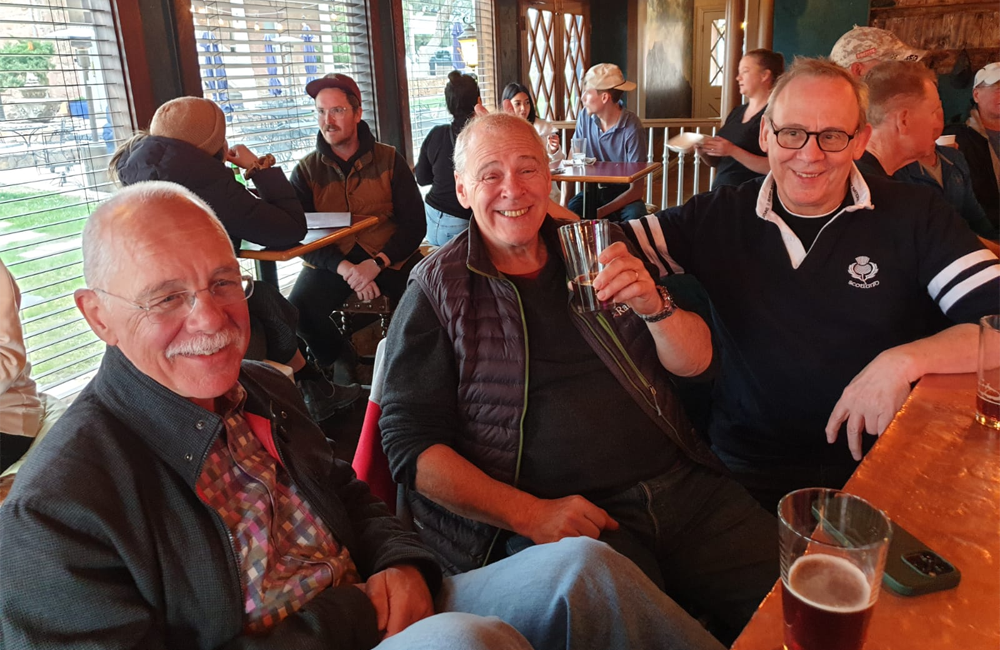
Joy of joys, at about mile 60, my European visitors came by in the van, with Nick playing suicide jockey, leaning out of the open sliding door to capture a video as they slowly passed us. They stopped, there were greetings, and then they set off for Fort Davis. They must have been a good omen because shortly after that Dave and I crested the pass, and to our delight enjoyed a ten mile downhill into Fort Davis. In fact the boys had only just sorted out their accommodation and were just strolling into town to look for our hotel / the bar, when we rolled right passed them again.
The Victorian-style Limpia Hotel was another funky favorite with its own personality, named after the local creek. Built in 1912 it was promoted as a cool summer retreat for wealthy cattlemen but, in reality, it served as a retreat for ranchers, travelers, and locals. It spread across several connected buildings, two of which were the bar and restaurant.
I sent Chris and Grimmy off to look for supplies with which to restock the happy hour cooler, while Nick helped me carry my bags and bike up to my first floor room. Man I was tired. But after an invigorating long hot shower we reconvened in the bar which as advertized was crammed between the hotel and the restaurant. What a wonderful hour or so. It is hard to express the power of the pride and the gratitude one feels when people go to such lengths just to show up in support. I didn't need us to talk, though talk we did, just sitting in their company in this strange place so far from home provided immeasurable comfort. One of my absolute favorite moments on the trip.
Finally the dinner bell clanged, and the bar emptied into the restaurant. I didn't want to hog the boys to myself, so we spread out across the crew. We announced we'd pick up the beer tab, which seemed the least we could do after Dennis insisted that my guests were his guests, and that might have aided the lively banter that sprang up as folks tried to get a rise out of them and vice versa.
The menu was not very imaginative as one might have expected, but several of us were persuaded to try Chicken Fried Steak for the first time. There was some lively banter about that too, because although beloved by many, for those of us who were new to it, it left a lot to be desired. I for one will probably never choose it again, but I loved choosing it then. It was perfect.
Monday March 20 Fort Davis TX. Day off with the boys!
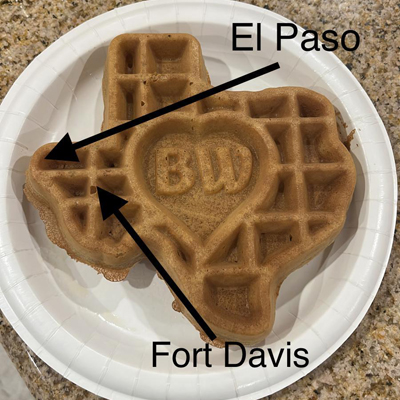
Amusingly, the following morning when I met the boys in a cafe on the main drag, I suddenly realized that it was the restaurant from last night, now re-configured as a cafe. Over breakfast we discussed the severely limited options for the day's entertainment. I needed to visit the National Historic Park, but everything else was an option. There was the 75 mile drive, there was the winery, there was the Rattlesnake Museum (huh?) and there needed to be a great dinner. Since this list seemed to be in everyone's priority order if we went counter-clockwise on the drive, we applied Thomsons’ Top Ten Travel Tip #8: "NEVER rush. Do the top thing for as long as it takes. If there is time, move to Item 2". Item #1: Fort Davis National Historic Park.
Fort Davis National Historic SiteFort Davis is one of the best surviving examples of an Indian Wars' frontier military post in the Southwest. A key post in the defense system of western Texas, Fort Davis played a major role in the history of the Southwest. From 1854 until 1891, the up to 700 enlisted men stationed here at the post protected emigrants, freighters, mail coaches, and travelers on the San Antonio-El Paso Road hoping to reach the gold fields of California. Today, Fort Davis is considered one of the best remaining examples of a frontier military post in the American Southwest. It is a vivid reminder of the significant role played by the military in the settlement and development of the western frontier. | |

|
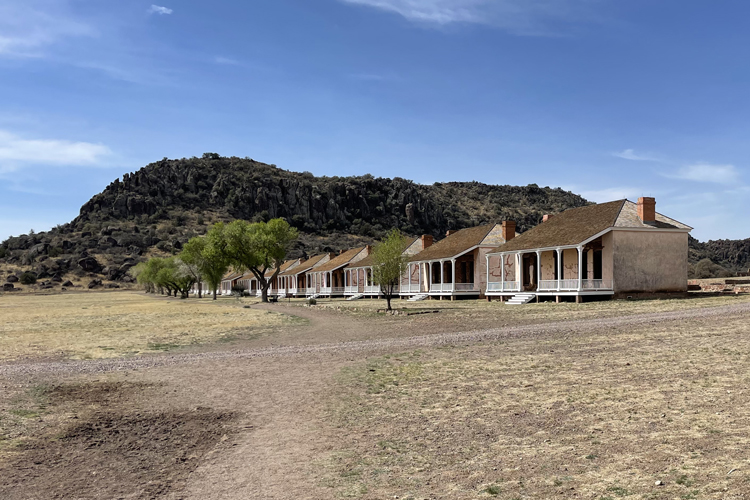
|
|
Fort Davis's primary role of safeguarding the west Texas frontier against the Comanches and Apaches continued until 1881. Although the Comanches were defeated in the mid-1870s, the Apaches continued to make travel on the San Antonio-El Paso road dangerous. Soldiers from the post regularly patrolled the road and provided protection for wagon trains and mail coaches. The last major military campaign involving troops from Fort Davis occurred in 1880. In a series of engagements, units from Fort Davis and other posts, under the command of Colonel Benjamin Grierson, forced the Apaches and their leader Victorio into Mexico. There, Victorio and most of his followers were killed by Mexican soldiers. With the end of the Indian Wars in west Texas, garrison life at Fort Davis became more routine. Soldiers occasionally escorted railroad survey parties, repaired roads and telegraph lines, and pursued bandits. In June 1891, as a result of the army's efforts to consolidate its frontier garrisons, Fort Davis was ordered abandoned, having "outlived its usefulness. |
|
I like this description I stole / adapted from the Texas Highways website: From a distance, the Davis Mountains float above the Chihuahuan Desert like a smoky mirage, rising up in green slopes punctuated by pine and oak trees, carpets of golden grasslands that wander through the canyons, and jumbles of rocky spires and escalating peaks. At more than 8,000 feet they are a dramatic contrast to the flatness of the surrounding desert.
Fort Davis is the starting point for The Davis Mountains Scenic Loop, (not least because it is home to the only gas station on route). Seventy-five miles long, it is one of the most scenic and uncrowded drives in Texas and America. The drive leaves Fort Davis on Texas 118, proceeds up Limpia Canyon past Mts. Locke and Fowlkes and the McDonald Observatory and then into Madera Canyon and thence back home to Fort Davis—but not without passing the winery.
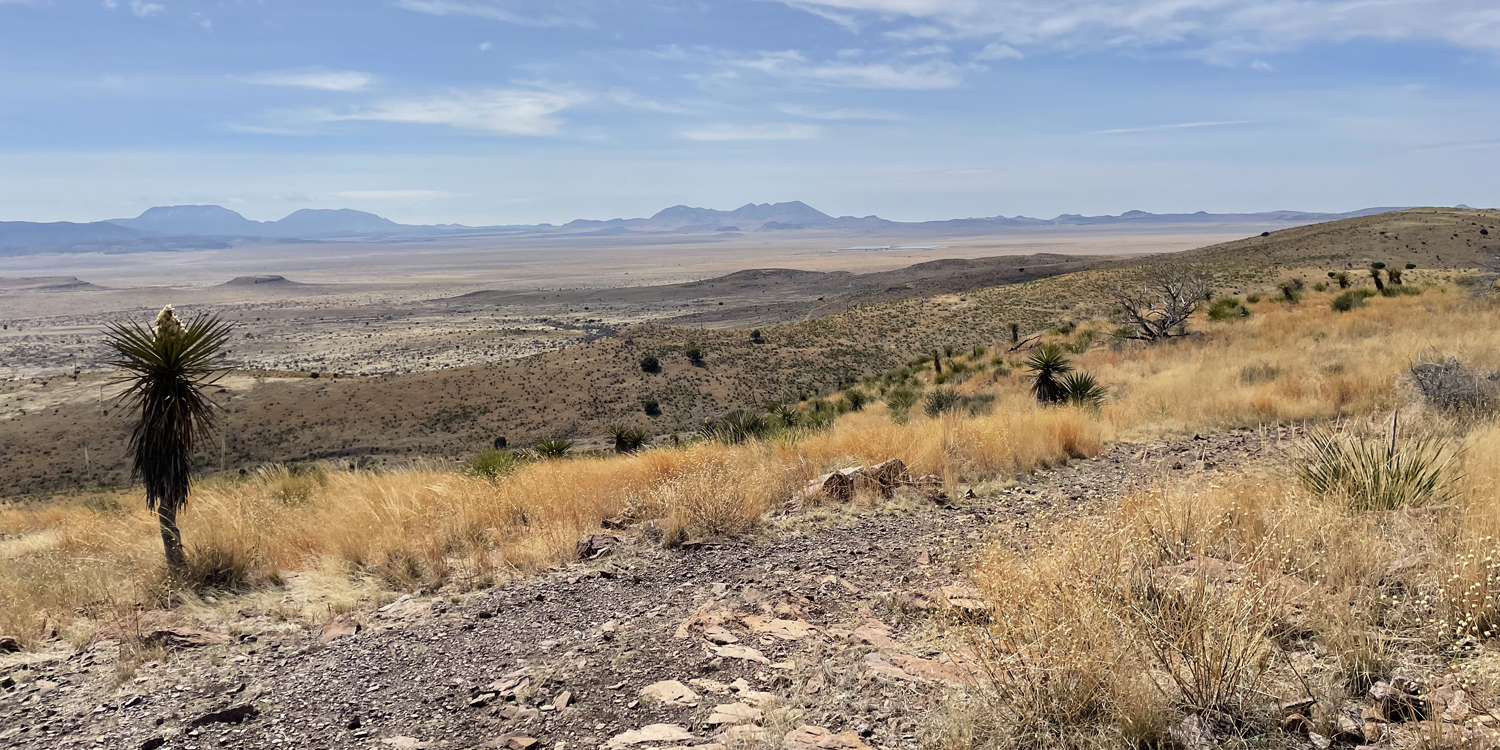
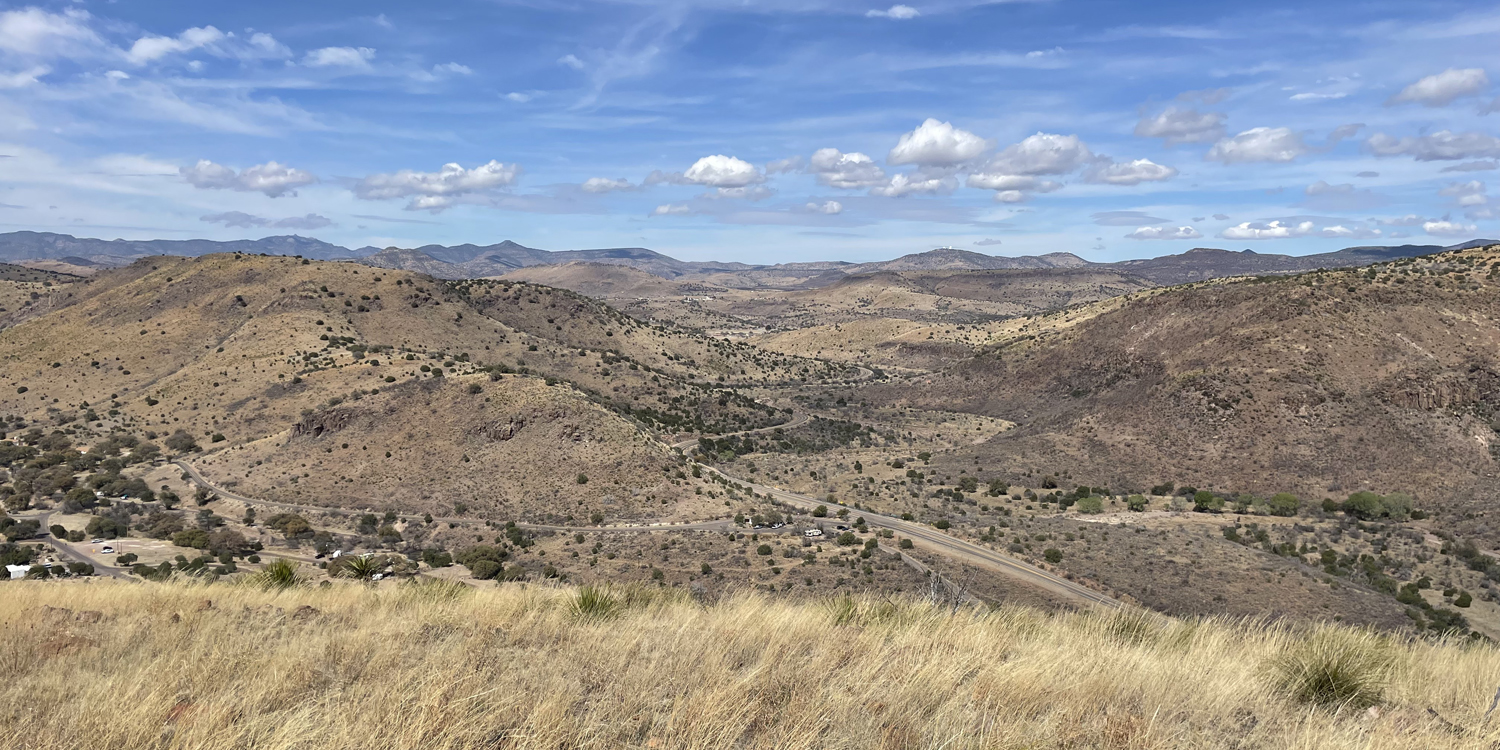
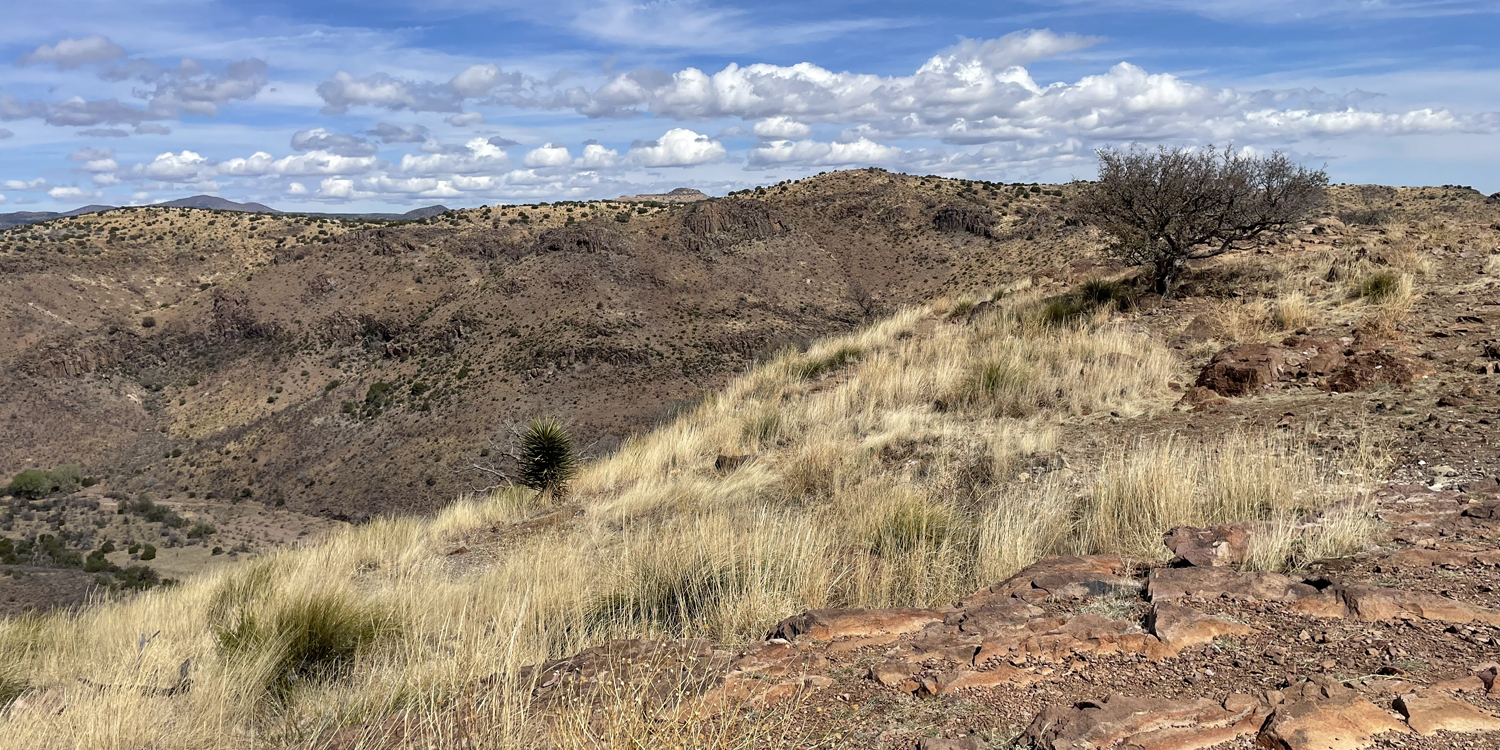
McDonald Observatory Sundial, the only attraction we has access to.
|
First stop on the trail, soon after leaving the Historical Park, Davis Mountains State Park. The 4.5-mile Skyline Drive Trail "meanders up and down mountain ridges and valleys". Meander it did but then afforded us some absolutely spectacular views including one back down onto the old Fort Davis. The McDonald Observatory, a research unit of the University of Texas and one of the world’s leading centers for astronomical study was next on the map. We stopped at the visitors center for a tour but true to form this was Monday and Monday was their day off, so we couldn't even get into the Visitor Center, never mind venture any further. Onwards. We stopped to chase some wild turkeys into the brush in the hope of a closer (camera!) shot but the judges were unanimous in awarding victory to the birds when Nick finally found his way back to the road. |
Wild turkeys at the fullest extent of our lenses.
|
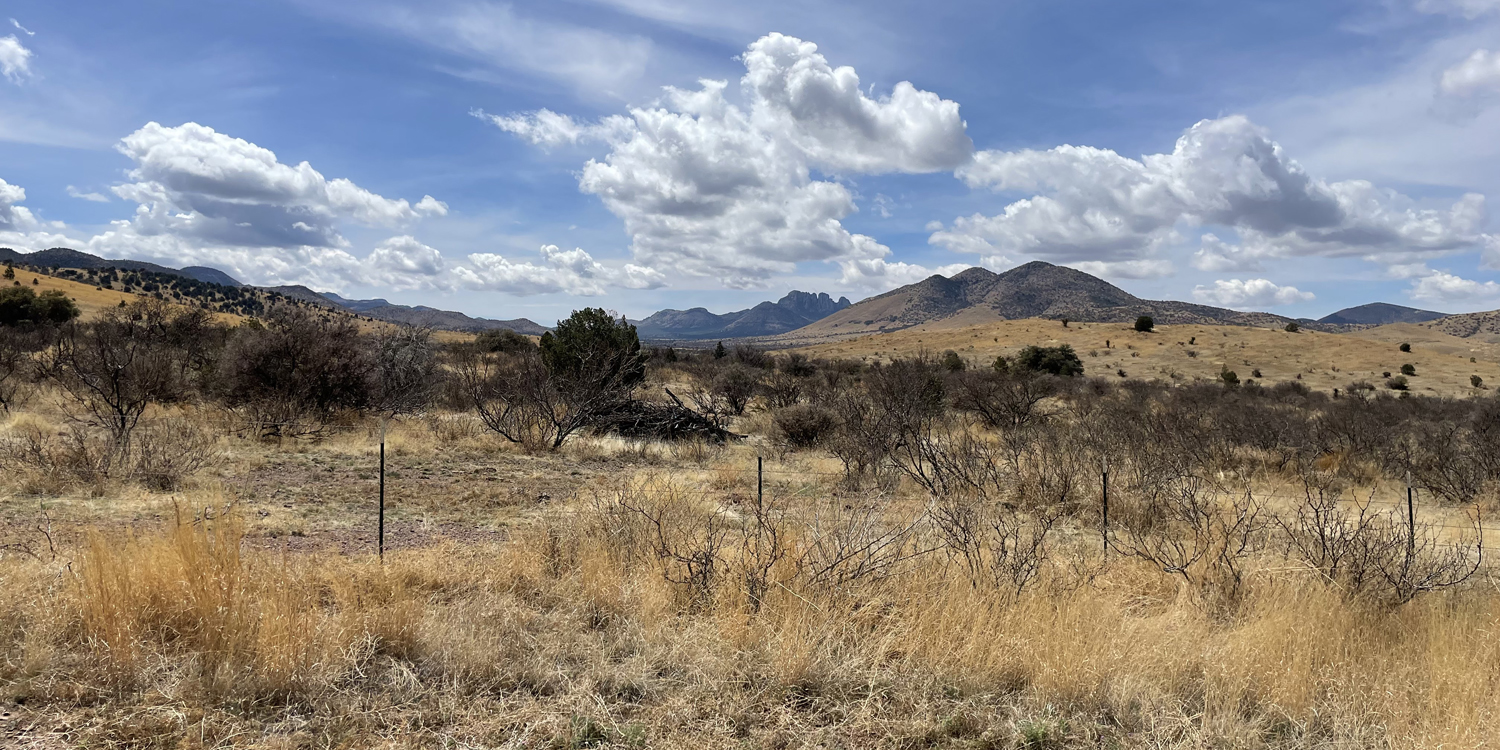
We made several other photo-op stops, but really the main pleasure was hanging out together, and for me, all those effortless ups and downs.
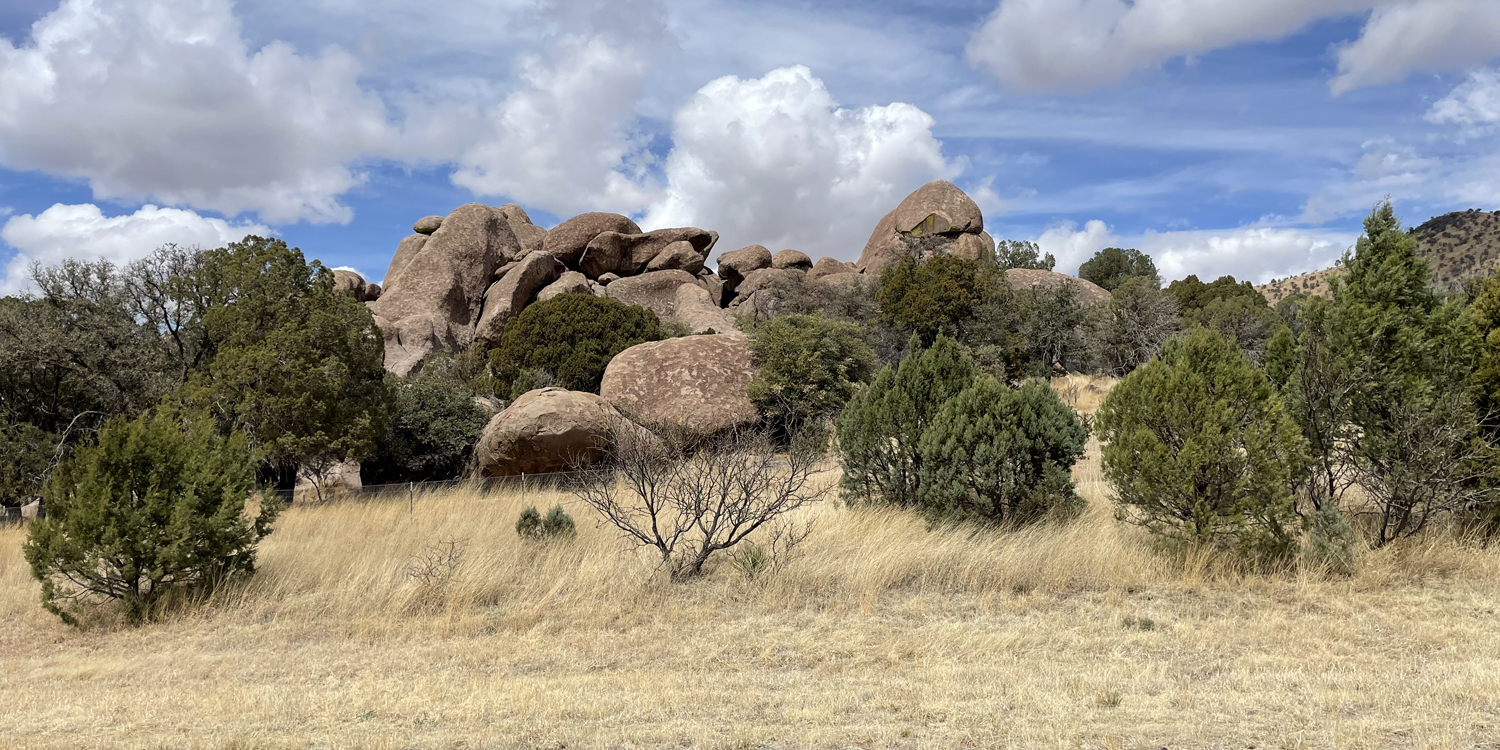
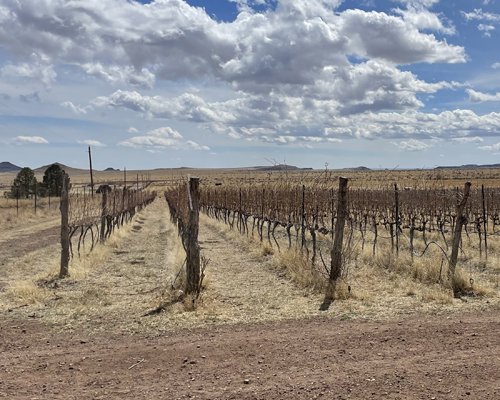
So by the time we were on the home straight back to Fort Davis, there was still time for Château Wright Winery and Sandwich Bar. They sported French-style reds which was a plus, and in the nick of time they had the souvenir corkscrew the boys had been looking for all trip. So last of the big spenders, we ordered a wine sampler to share between the four of us. It was all a little pretentious for the tiny, shoestring budget place it was. The sandwich bar was very tired old caravan with a serving hatch inside which sat was a lonely guy reading his phone.
Having said that, the couple of appetizers we bought were excellent when they came. We pompously passed each glass around for our small sip. They did seem to get better as we moved our way to the right of the flight. Until we got to one that seemed off to me. Interesting problem: do we make complete asses of ourselves by complaining about something that is actually okay, or do we make complete asses of ourselves by not complaining about something that is subsequently proven to indeed have a problem. Nothing ventured nothing gained, we went with Option A. The waitress tried the wine and agreed it was indeed not right (or she was classy enough to side with the customer?) so she gave us the flight for free (there was no more of the offending stuff so it could not be replaced). All in all a pleasant enough interlude.
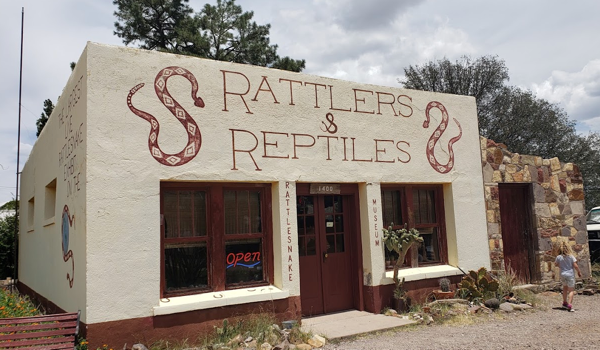
As we completed the circuit back in Fort Davis, we realized we still had time to take a swing at the Rattlesnake Shop if we could get someone to answer the door. The Rattlers And Reptiles Rattlesnake Museum was quirky from start to finish, head to toe. First up, for the "largest collection of live rattlers in the world" it is tiny. Then although this was within opening hours, we had to call the proprietor to come open up. At $7 a head for 15 or 20 minutes of viewing time (plenty, at least for us) it wasn't cheap.
But fair dos it was filled with all types of rattlesnakes. I've been to zoos that have had more snakes, and much bigger ones but this place definitely had them beat for variety. There were rattlesnakes of all colors; red, white, brown, black, yellow, and grey. The rattlesnakes were from all over the USA and in all shapes. There were also a few scorpions, and tarantulas. But the creepiest thing in the building was the custodian. Exactly the kind of guy who got his kicks catching rattlers. I bet he was a killer poker player too. Nothing describes him better than the exchange I had with him about a bowlful of pebbles with a label which said: "Indian Love Stones: $2"
RT: "WT ... ?"
Custodian: "It's just a fucking rock." (See what he did there? Love stones : Fucking rocks)
Custodian: "And now I have your $2"
Best laugh I had all day.
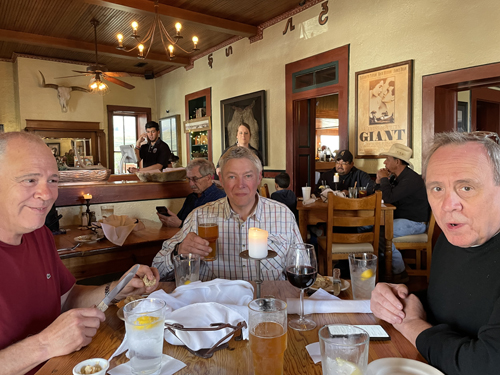
Time for supper. Since it was The Last Supper, we agreed it needed to be special, and Fort Davis though cute, was not cut out for special. So we drove 20 or so miles along tomorrow's route to Alpine, the county seat. What a spectacular road. I thoroughly looked forward to riding it again, but took advantage of this extra time to take a bunch of pictures so I wouldn't have to keep stopping in the morning. We also spotted javalinas which we failed miserably to capture on film. Worse Nick our best photographer by far wasn't trying very hard because "they are just pigs and I already have pig pictures". (He's trying to record every mammal he's seen, He was horrified to discover later that these were a legitimate separate species.
Reata Restaurant Alpine was exactly what the Doctor ordered. Very Texan feel, buffalo horns, cowboy equipment and old wild west posters, starched white napkins and a Mexican bias to the menu. I had Tortilla soup, and Fried Poblano Chile Relleno: Two Bacon Wrapped Crab Stuffed Jalapenos. The boys had steaks of course.
And that was that. Back to base for a nightcap and a sad fairwell. We would be on the road before the boys got up in the morning to start the long ride home.
